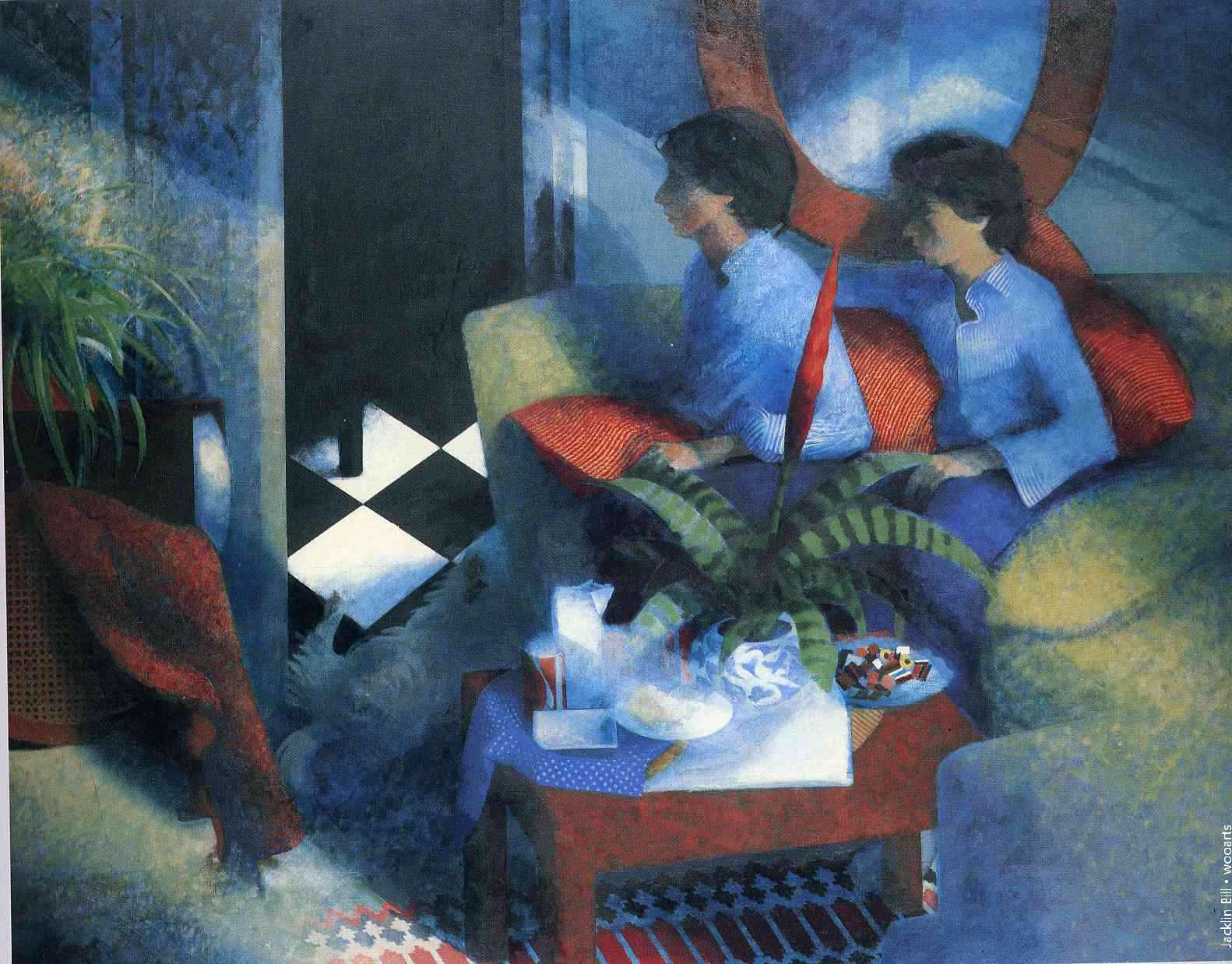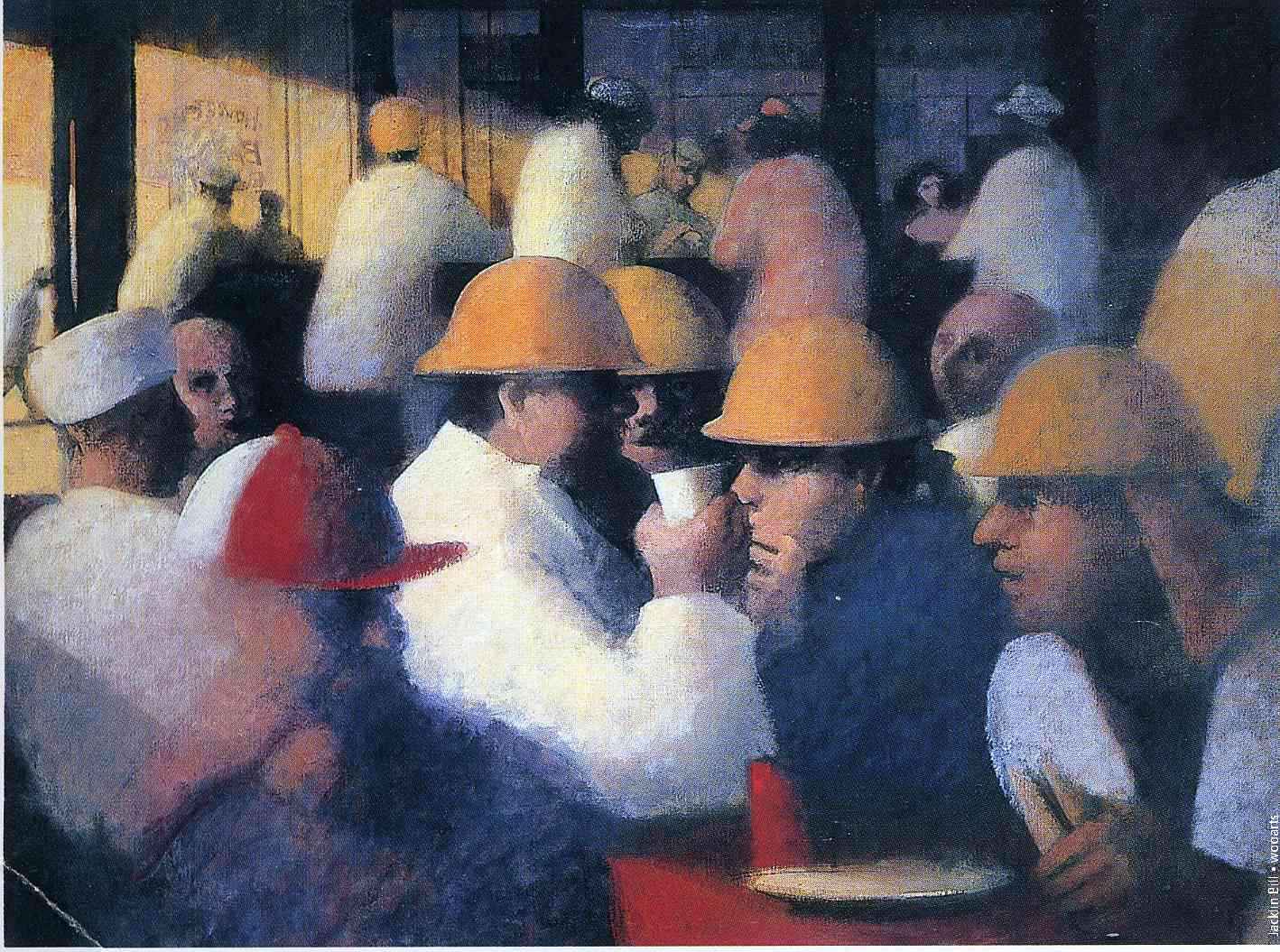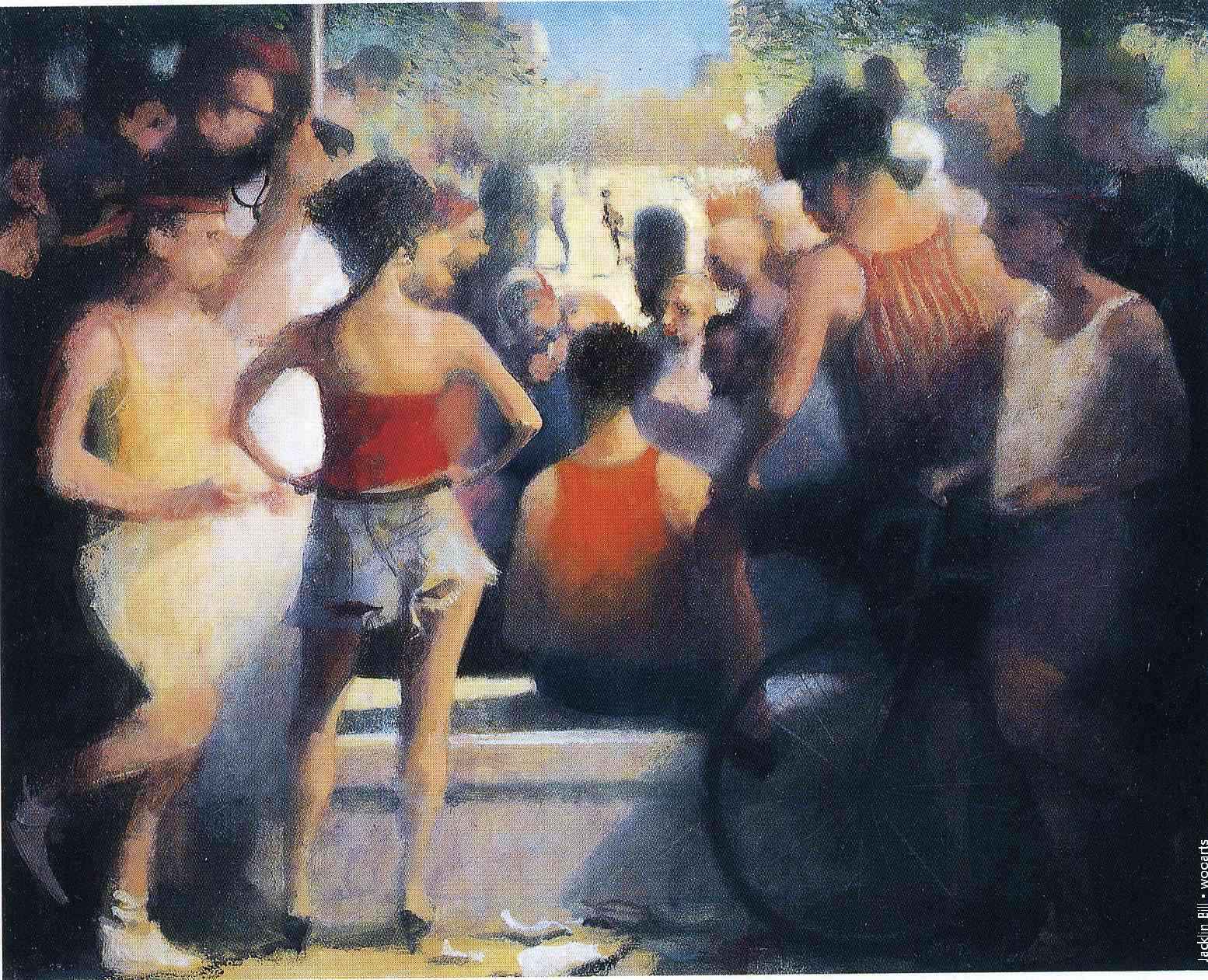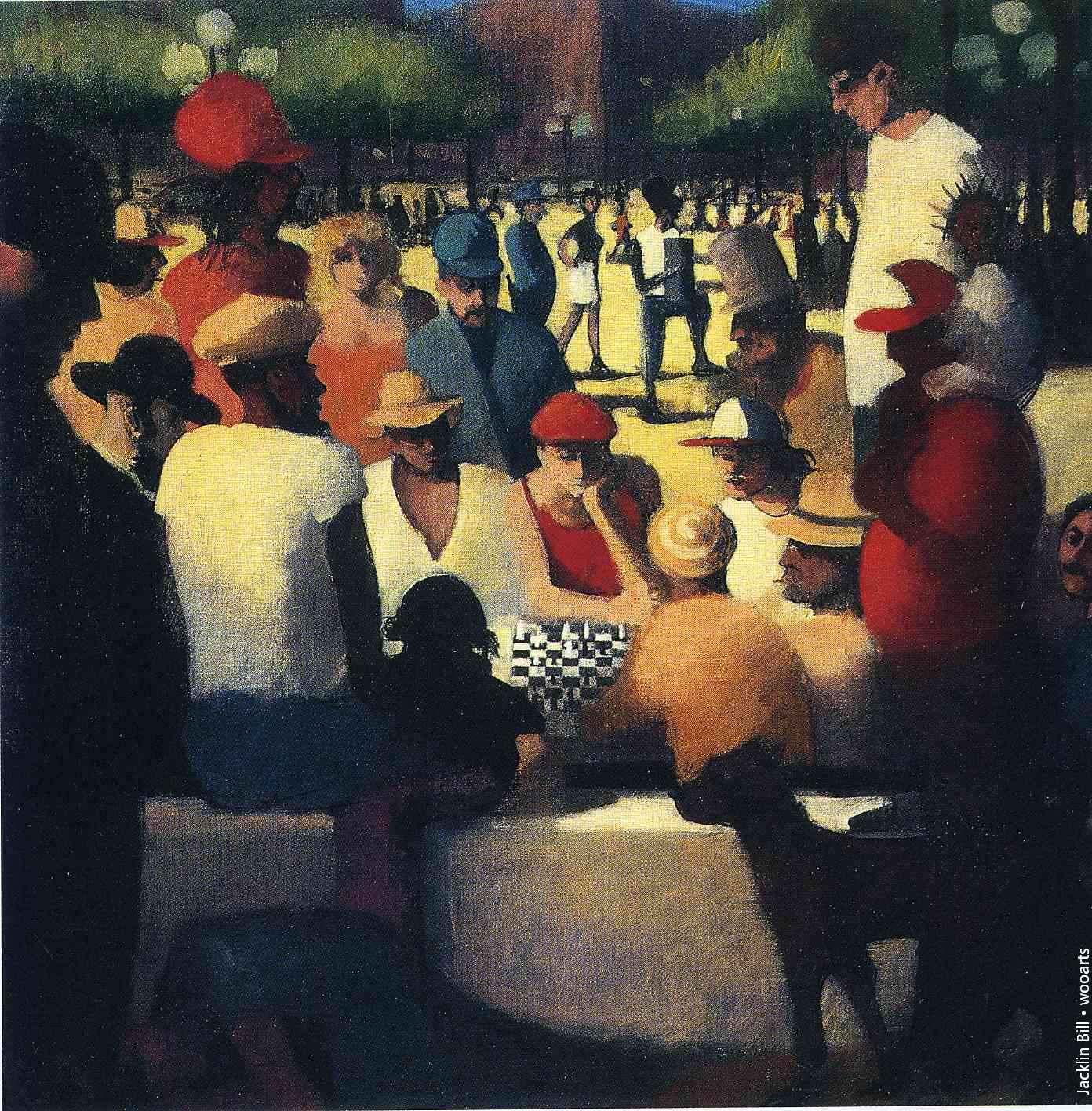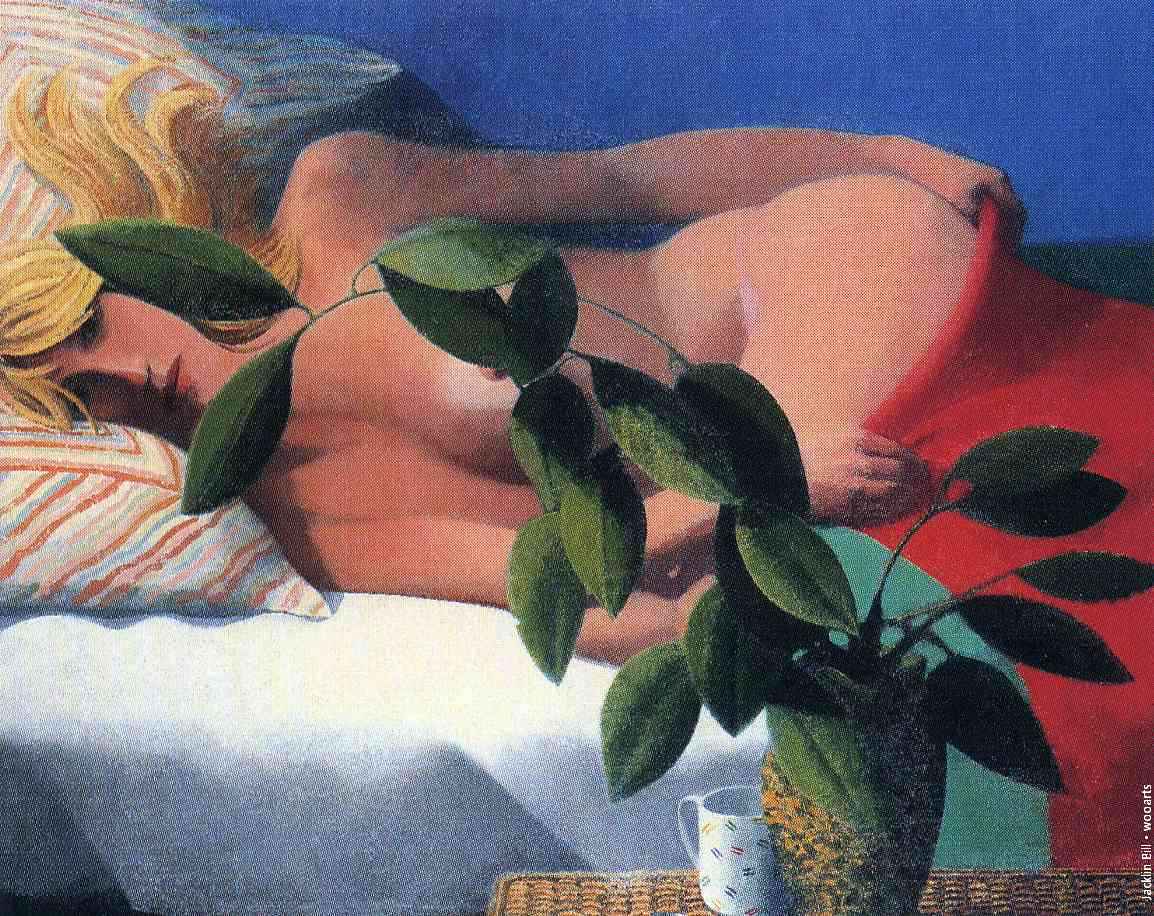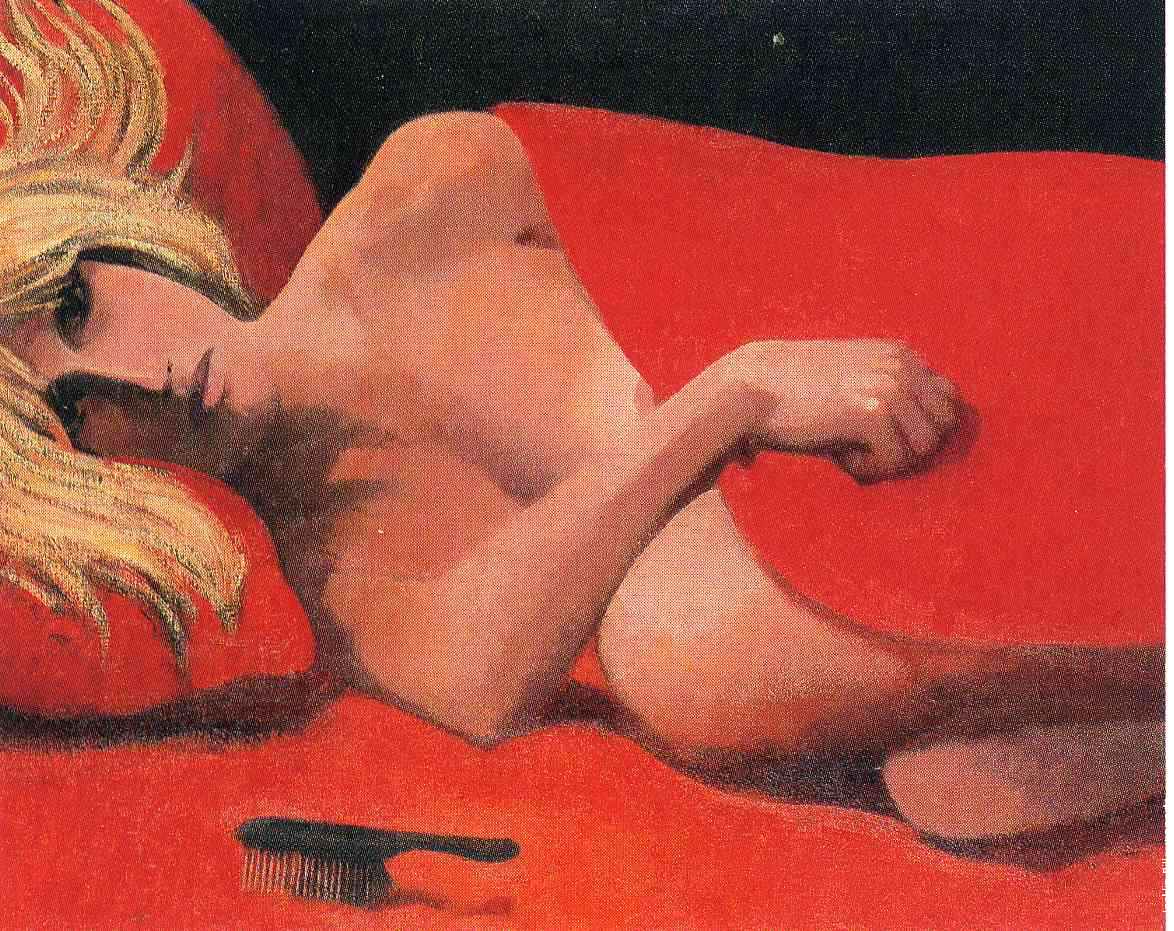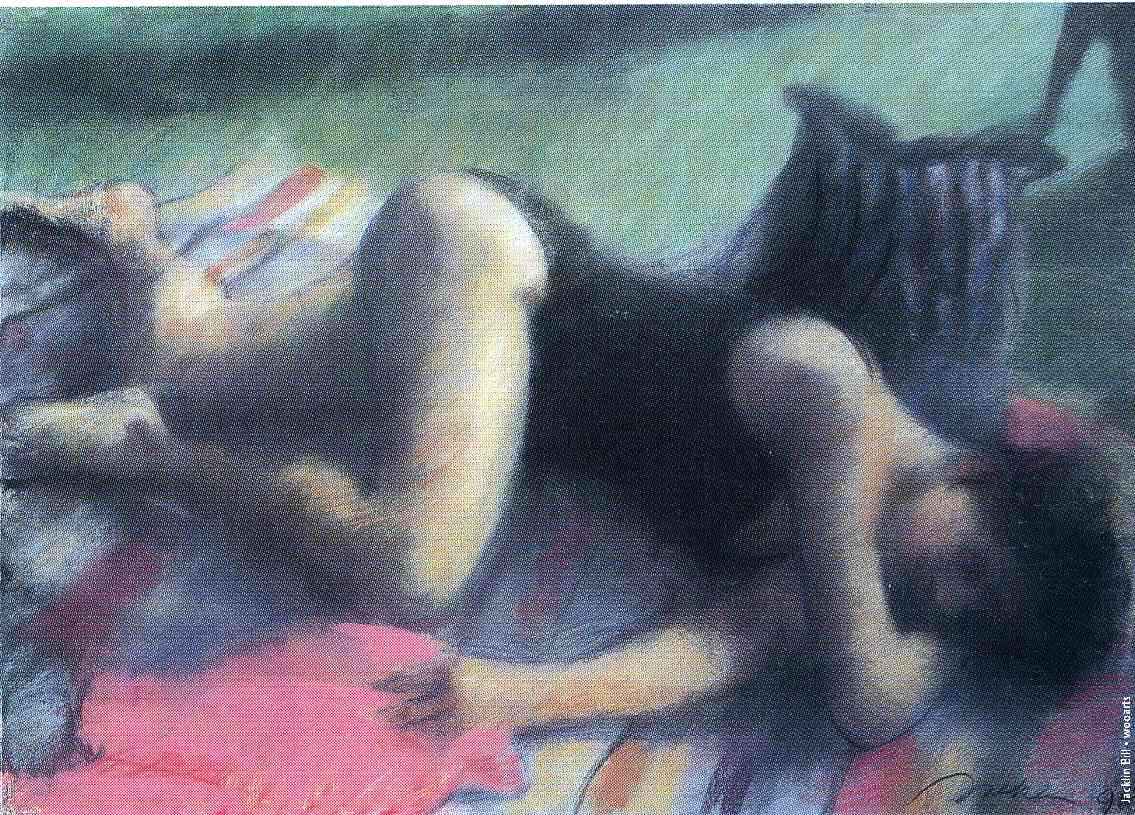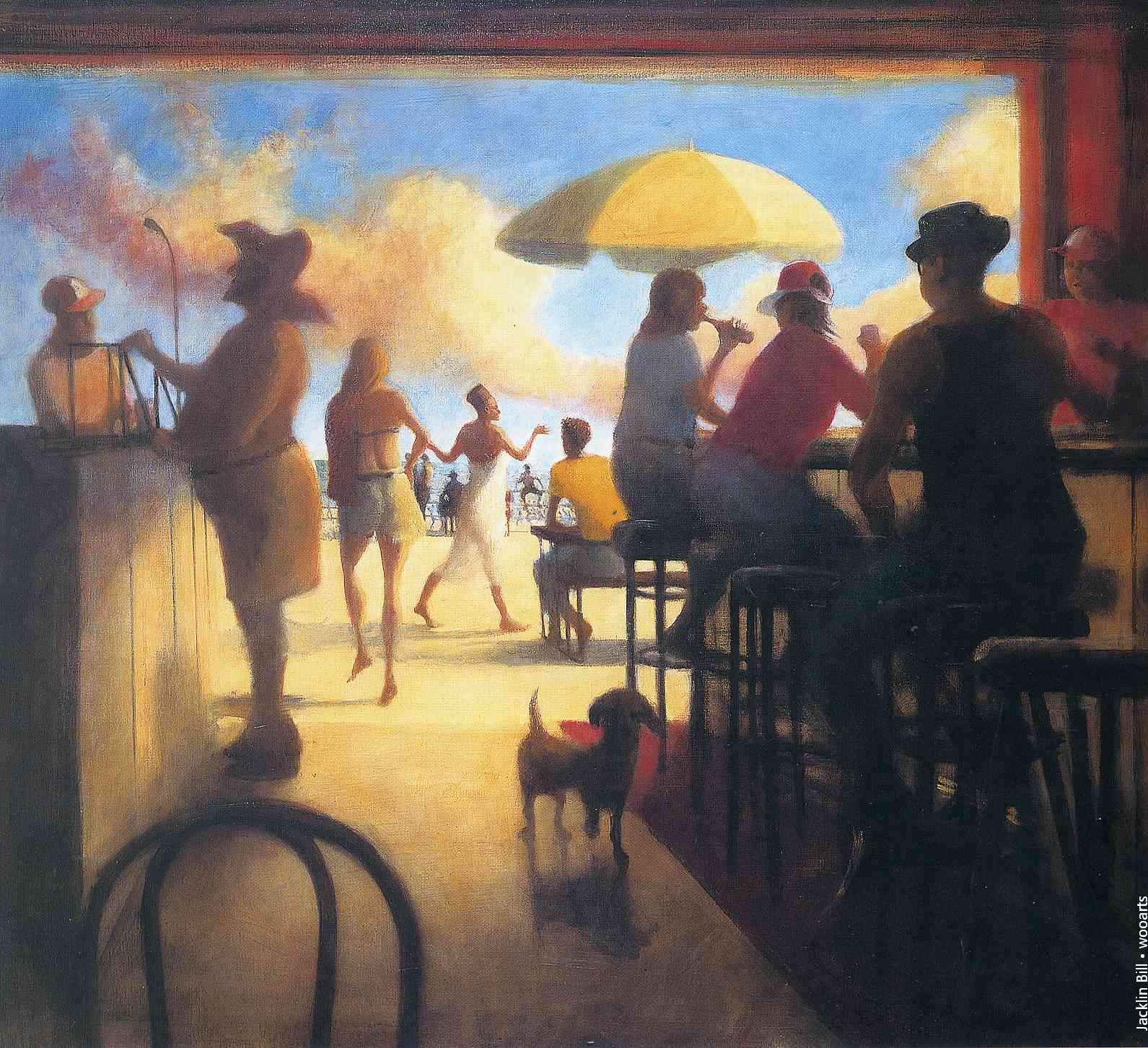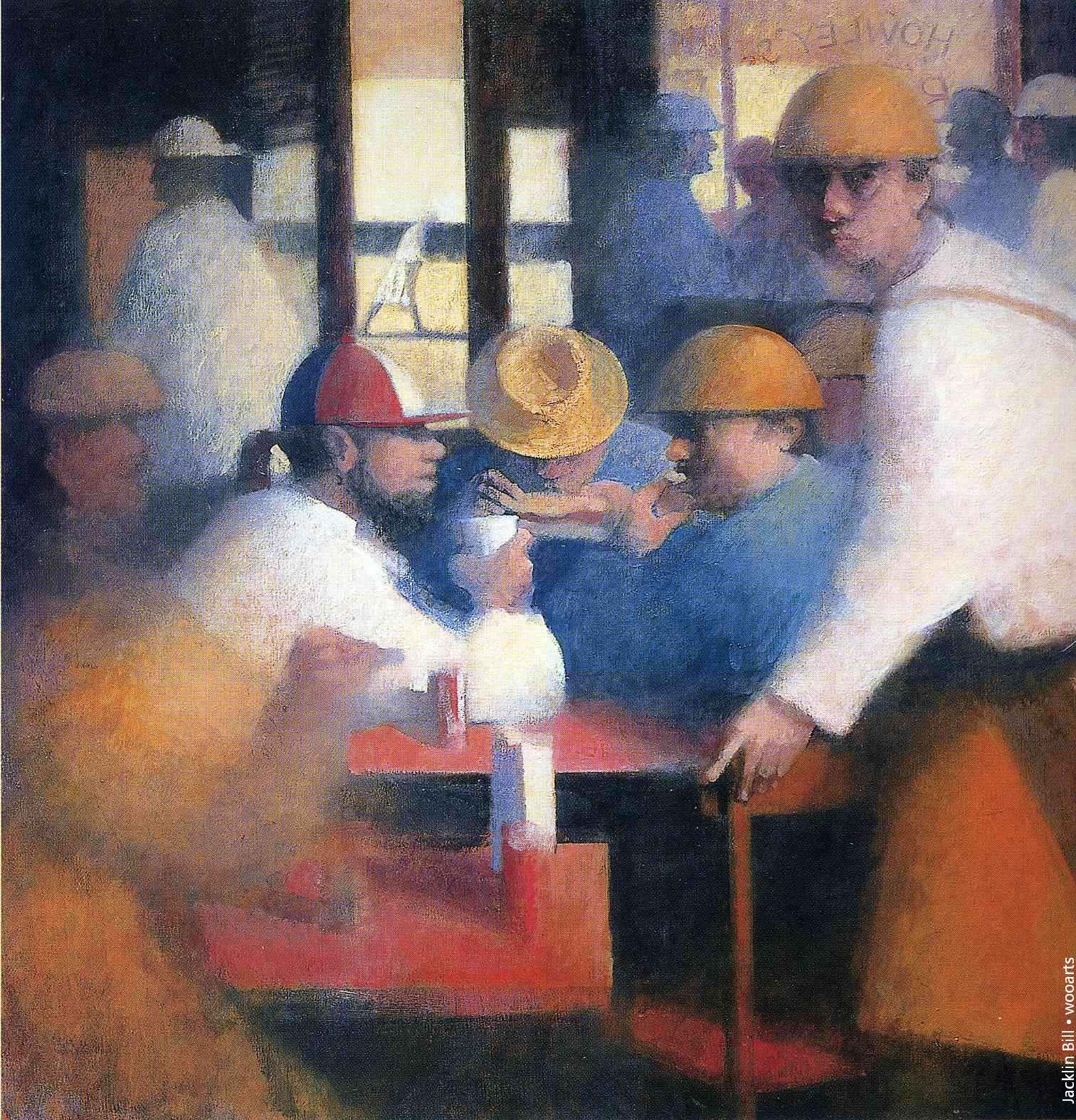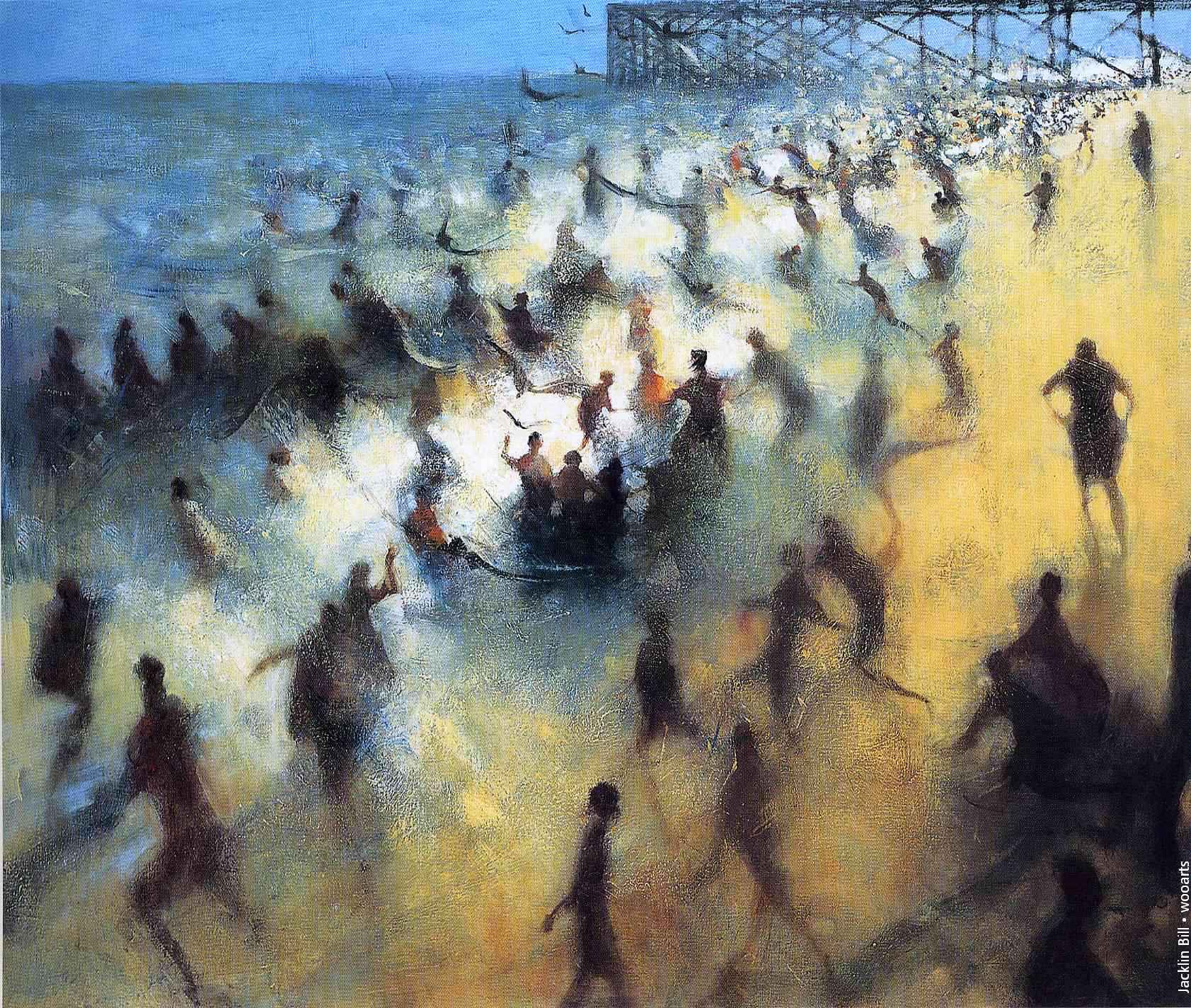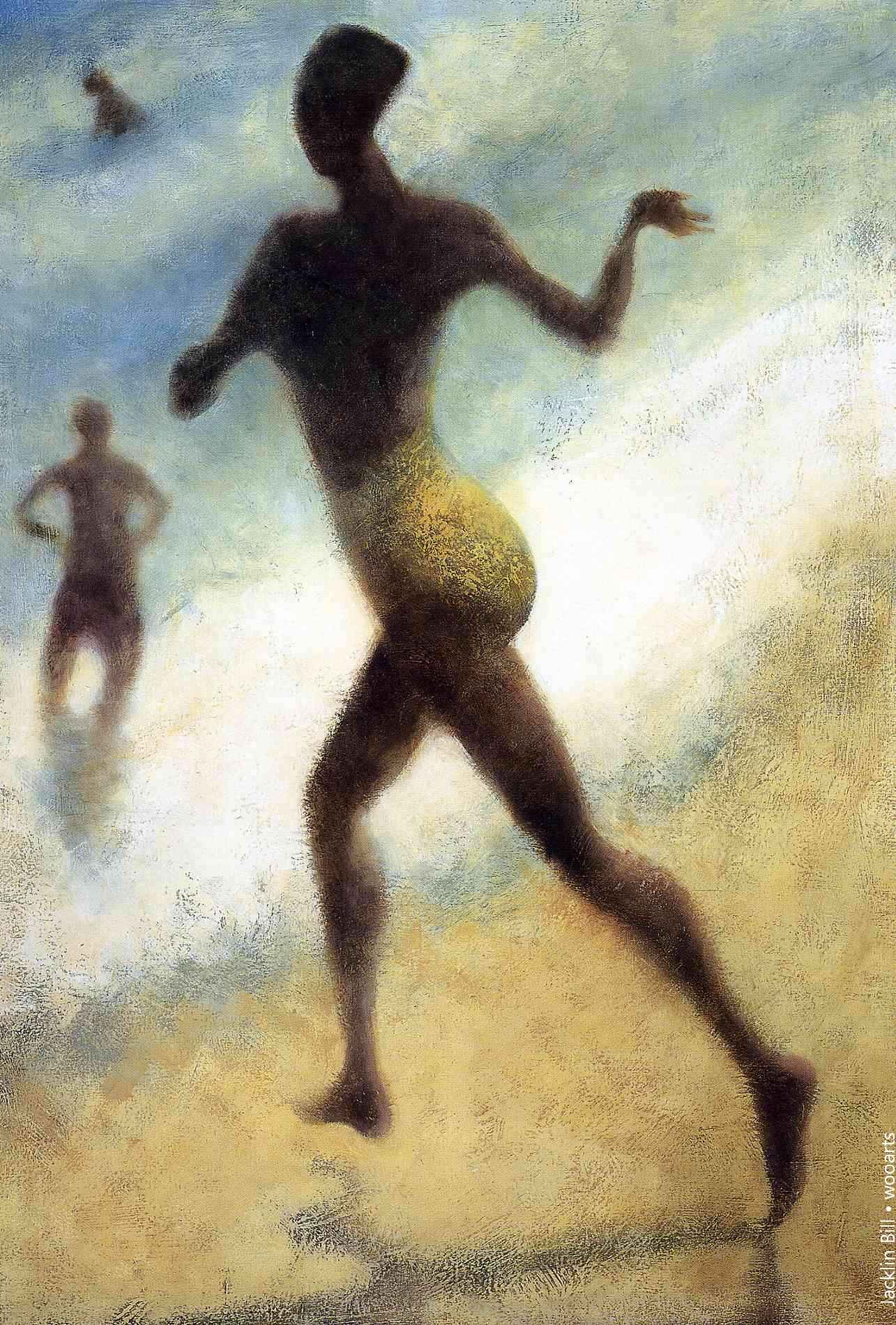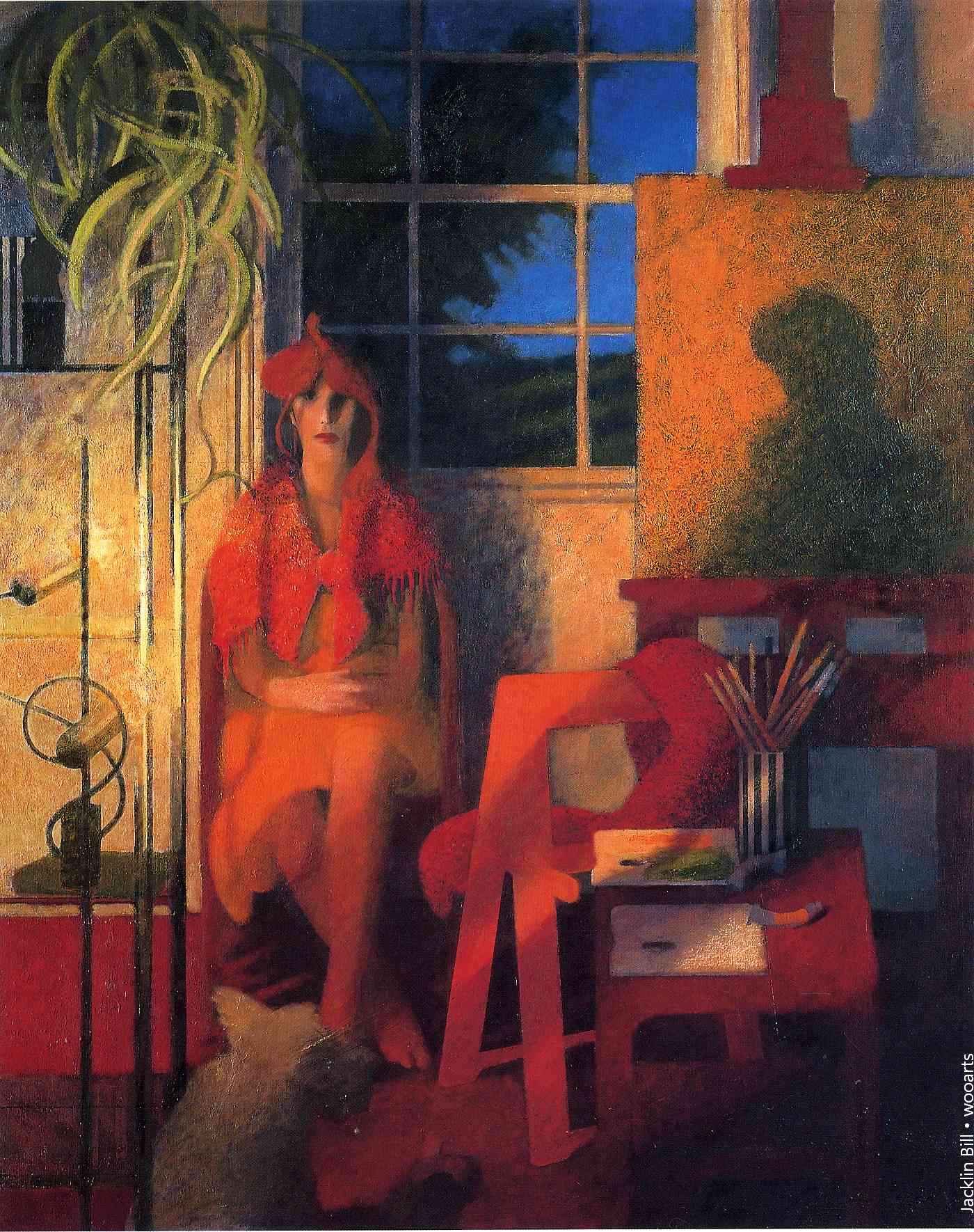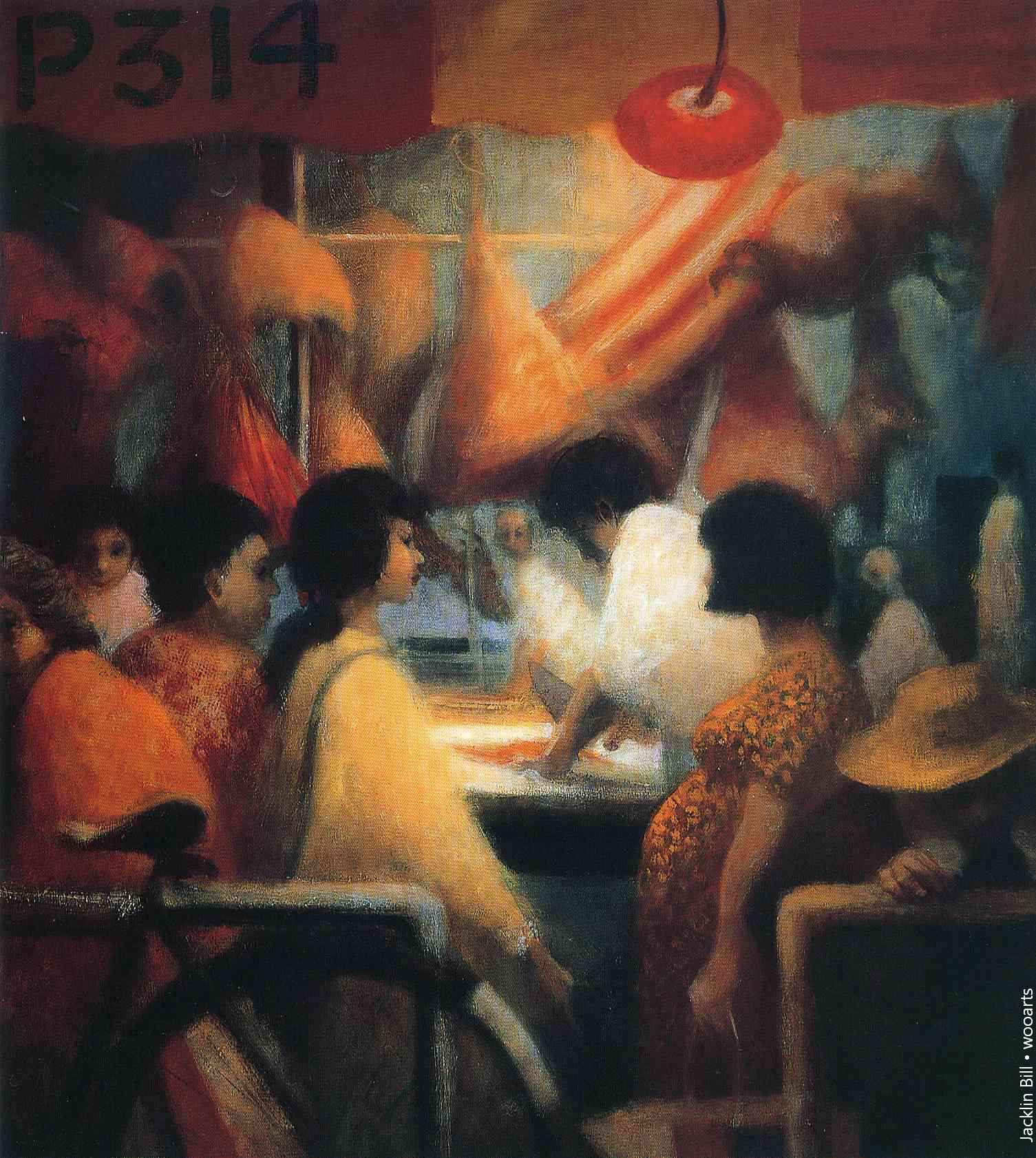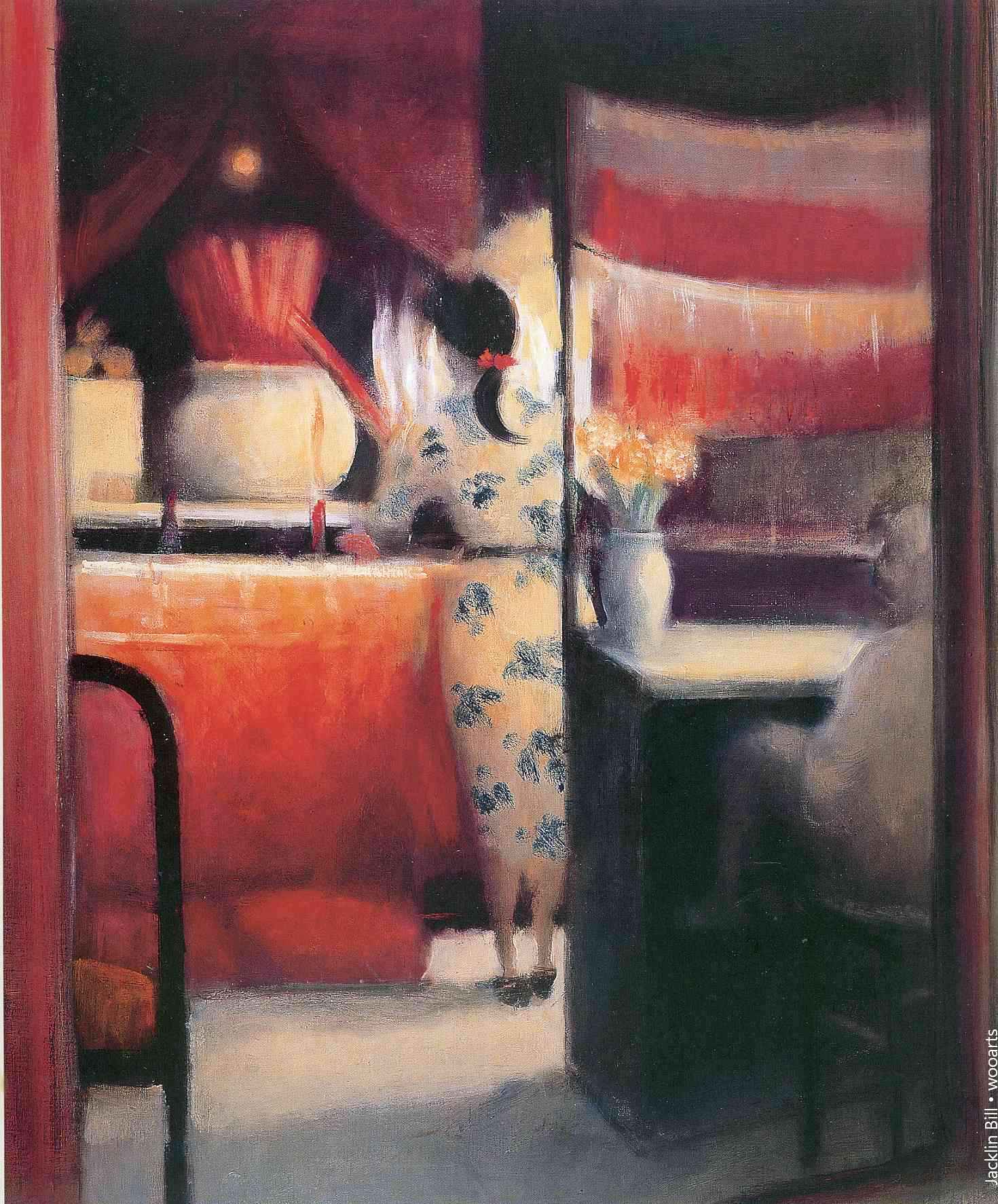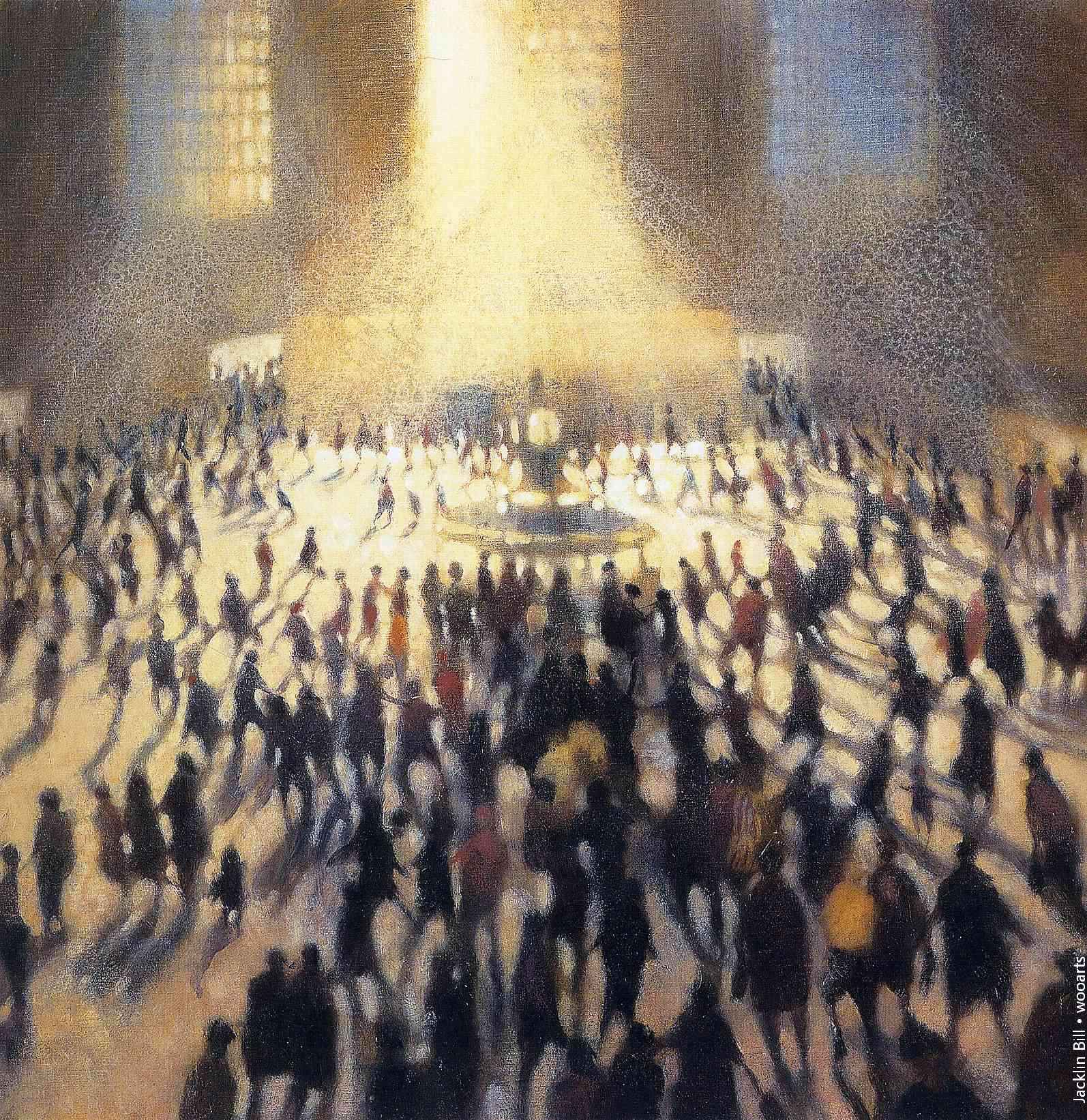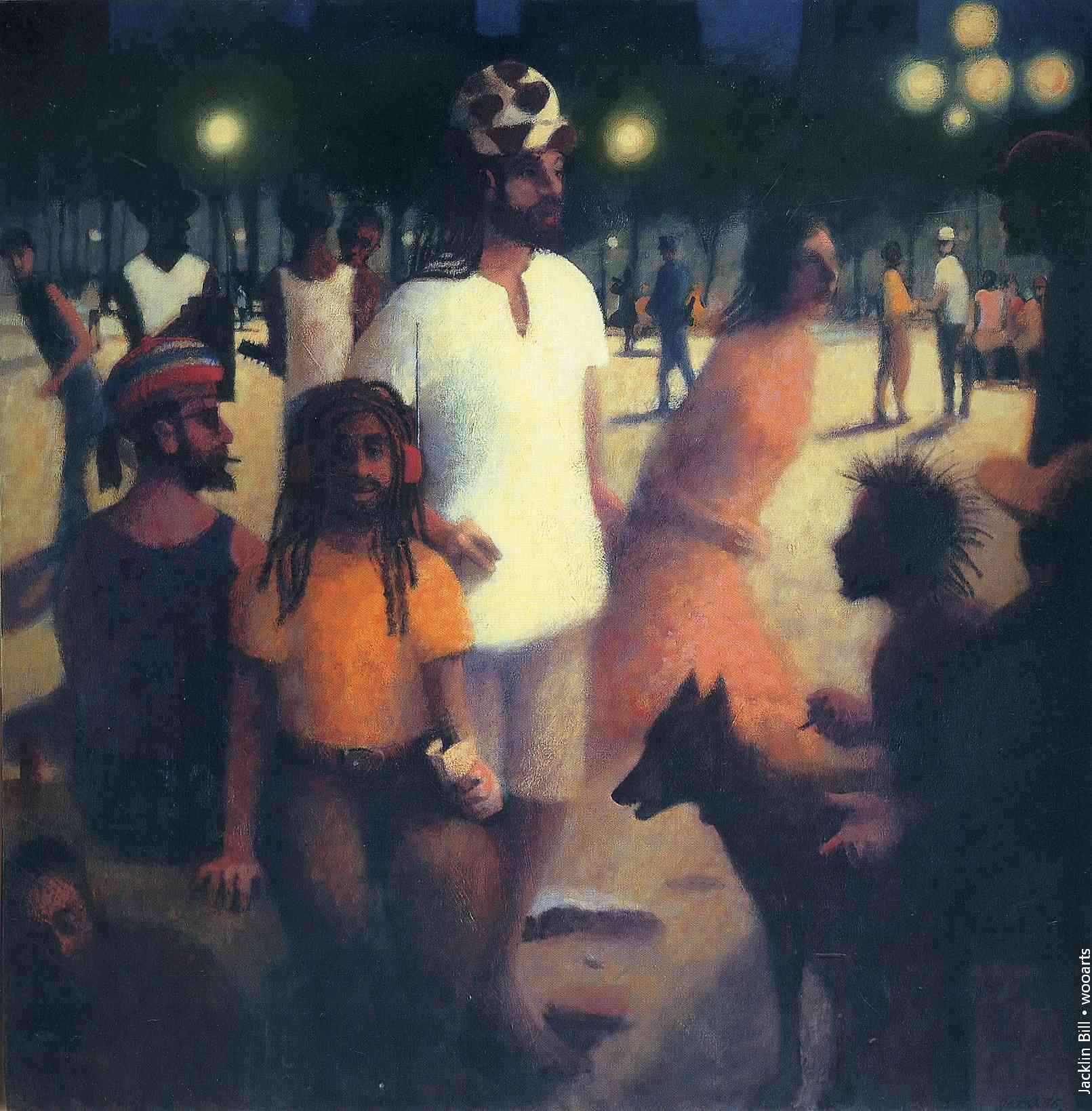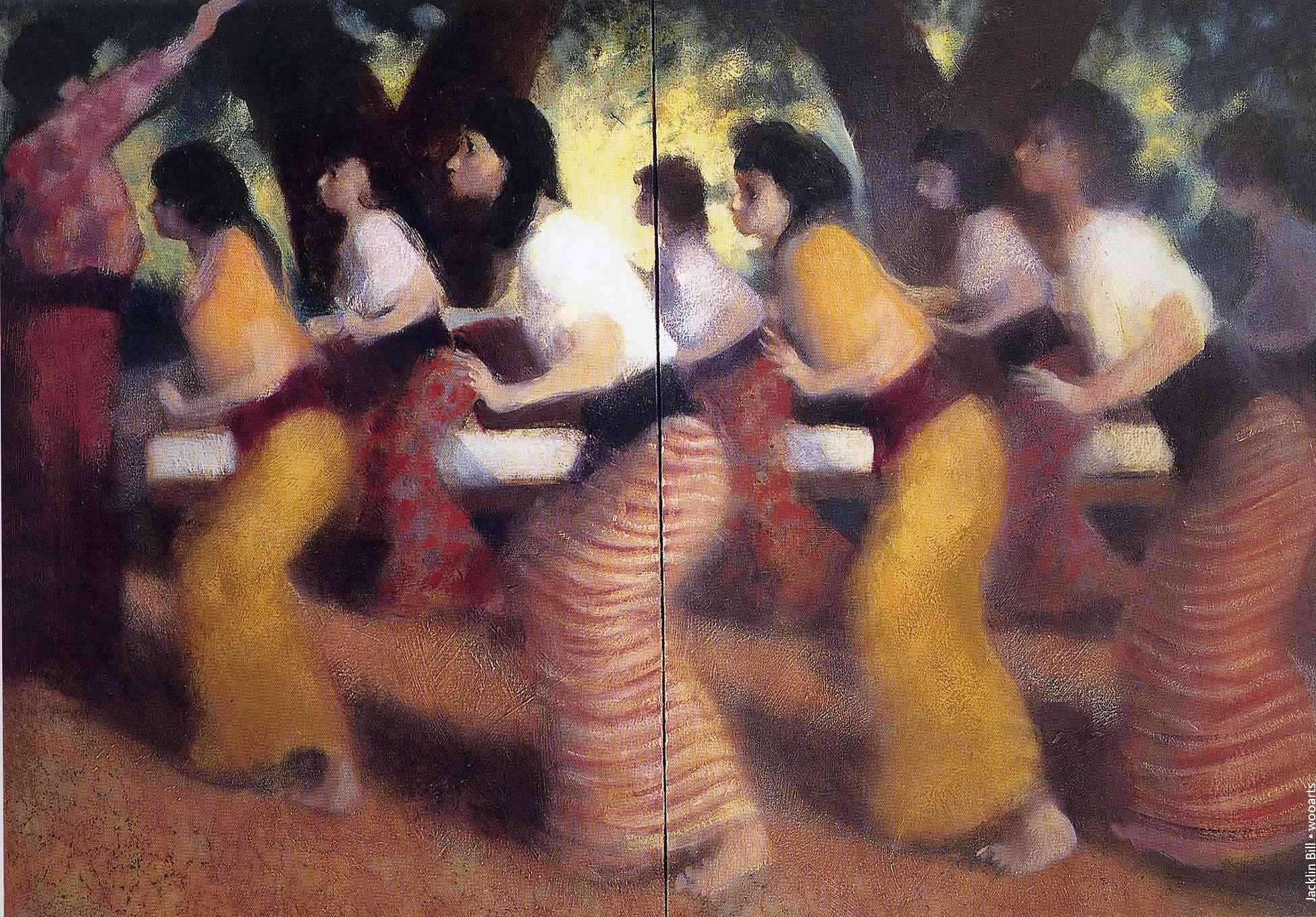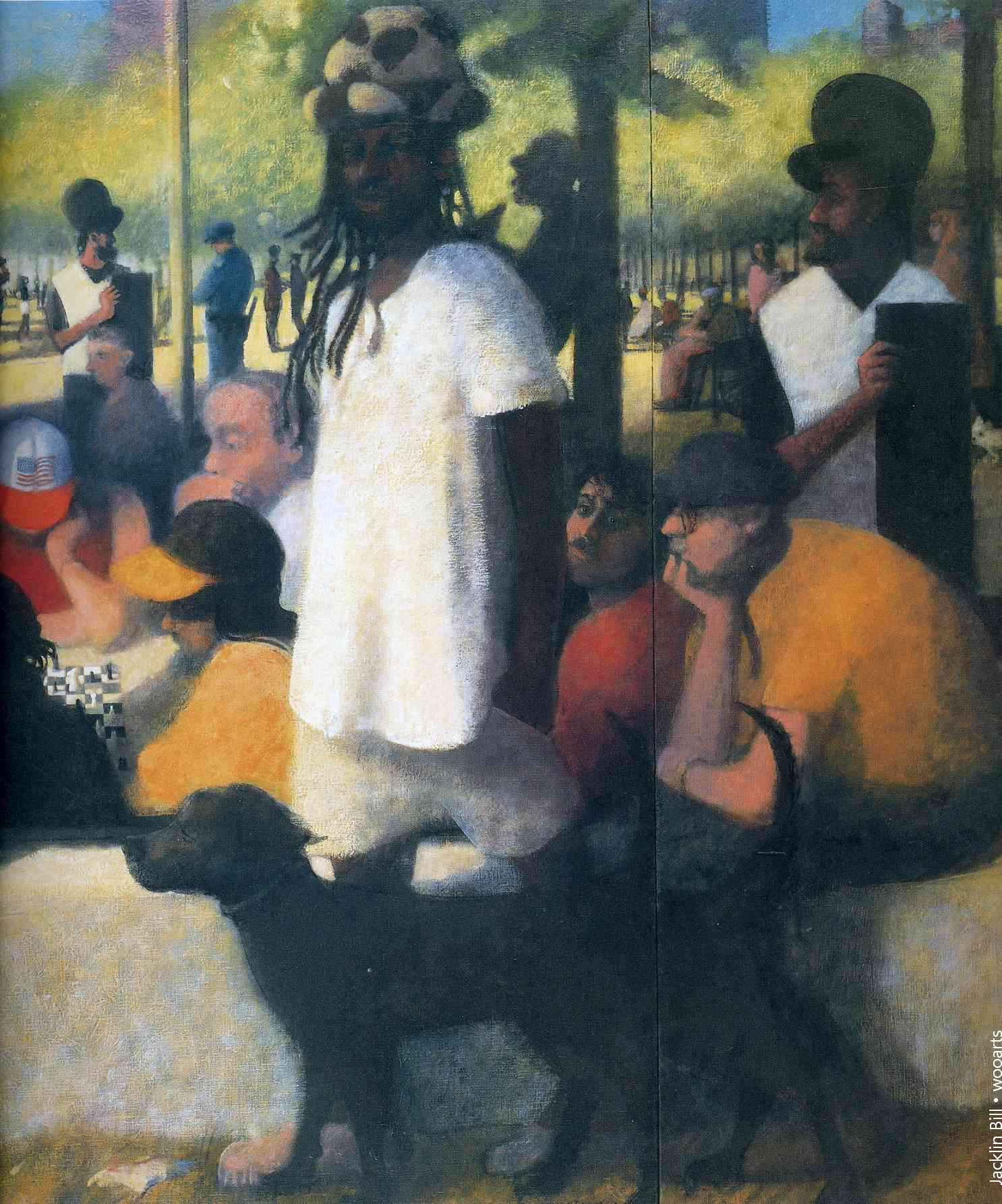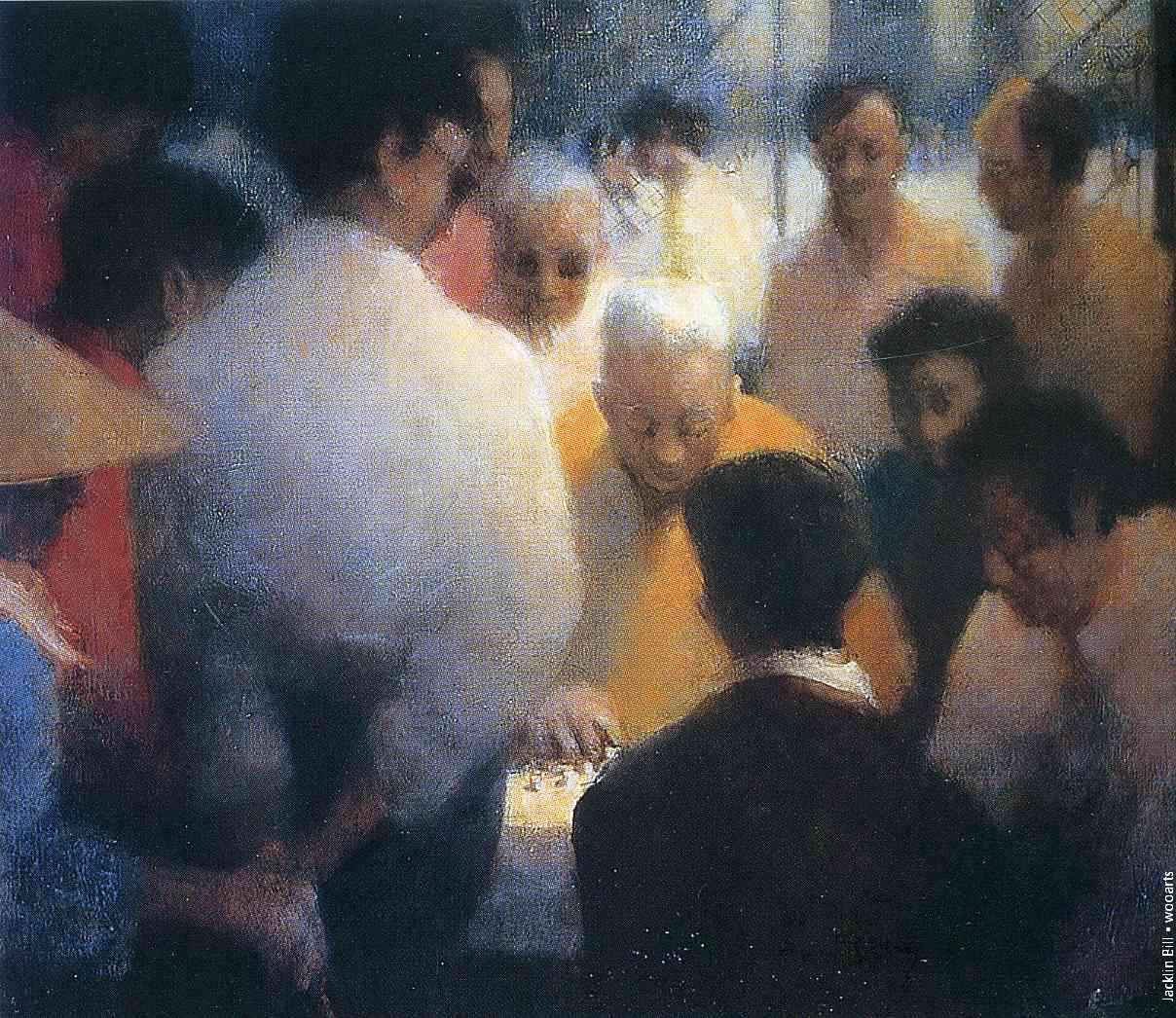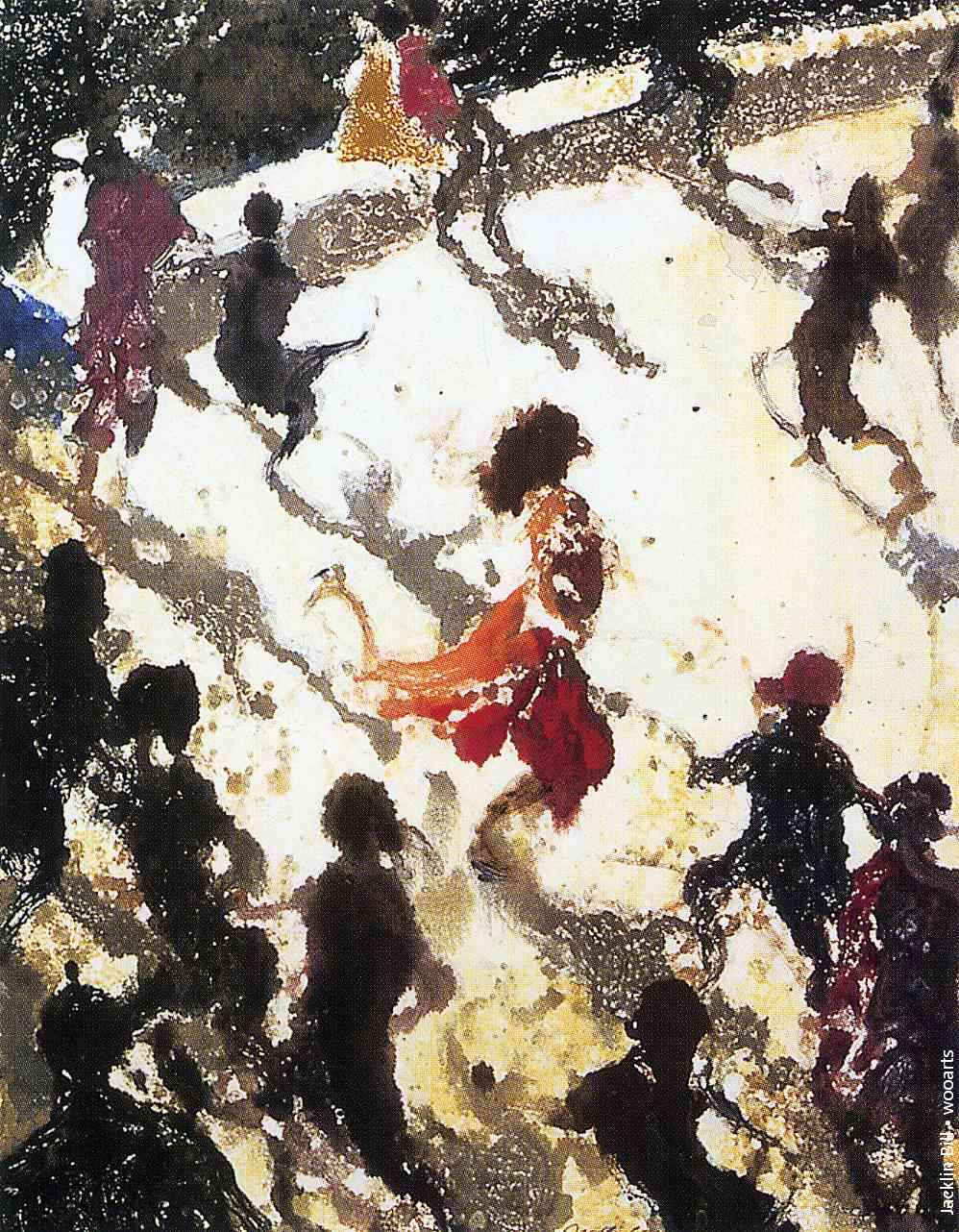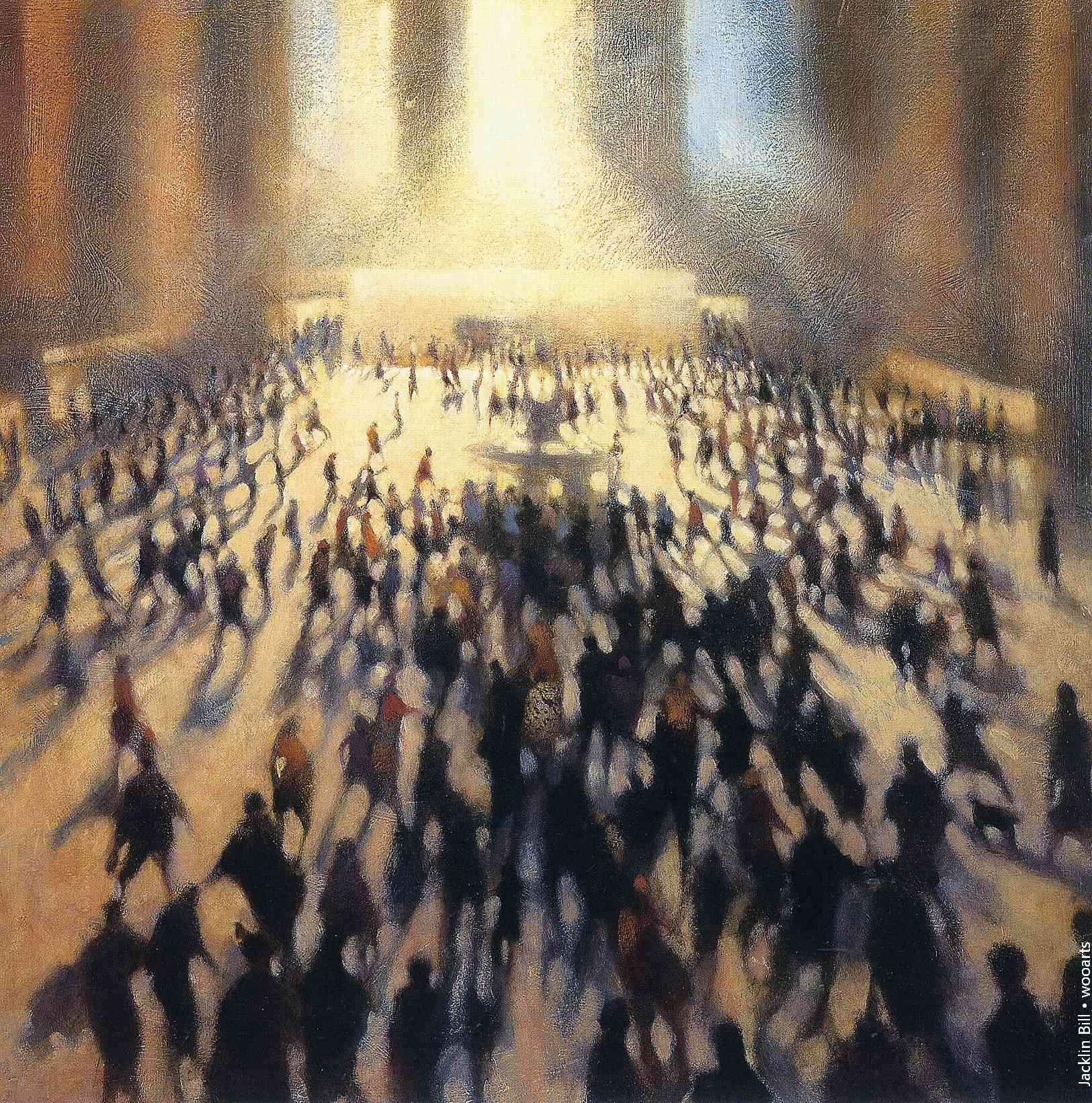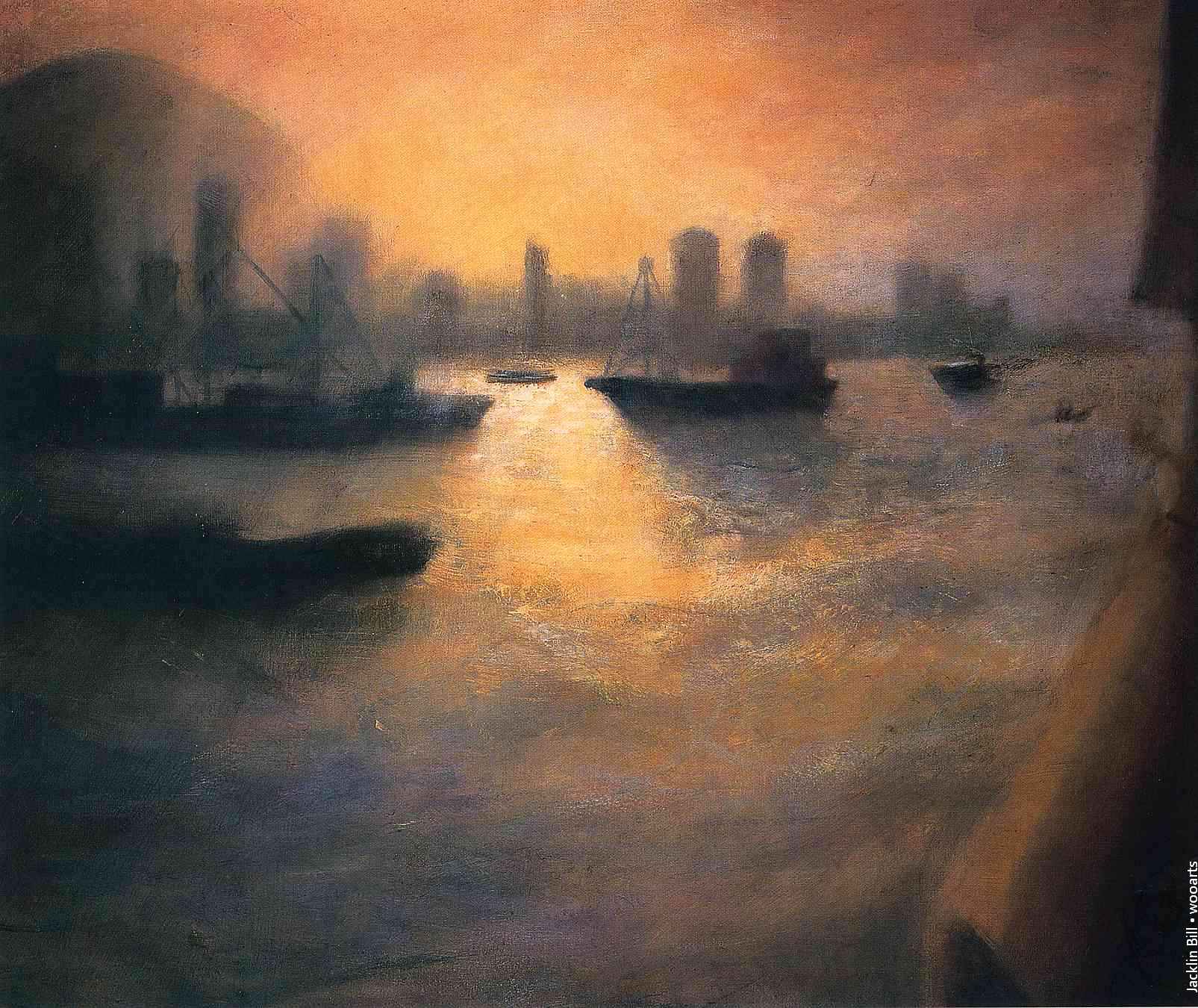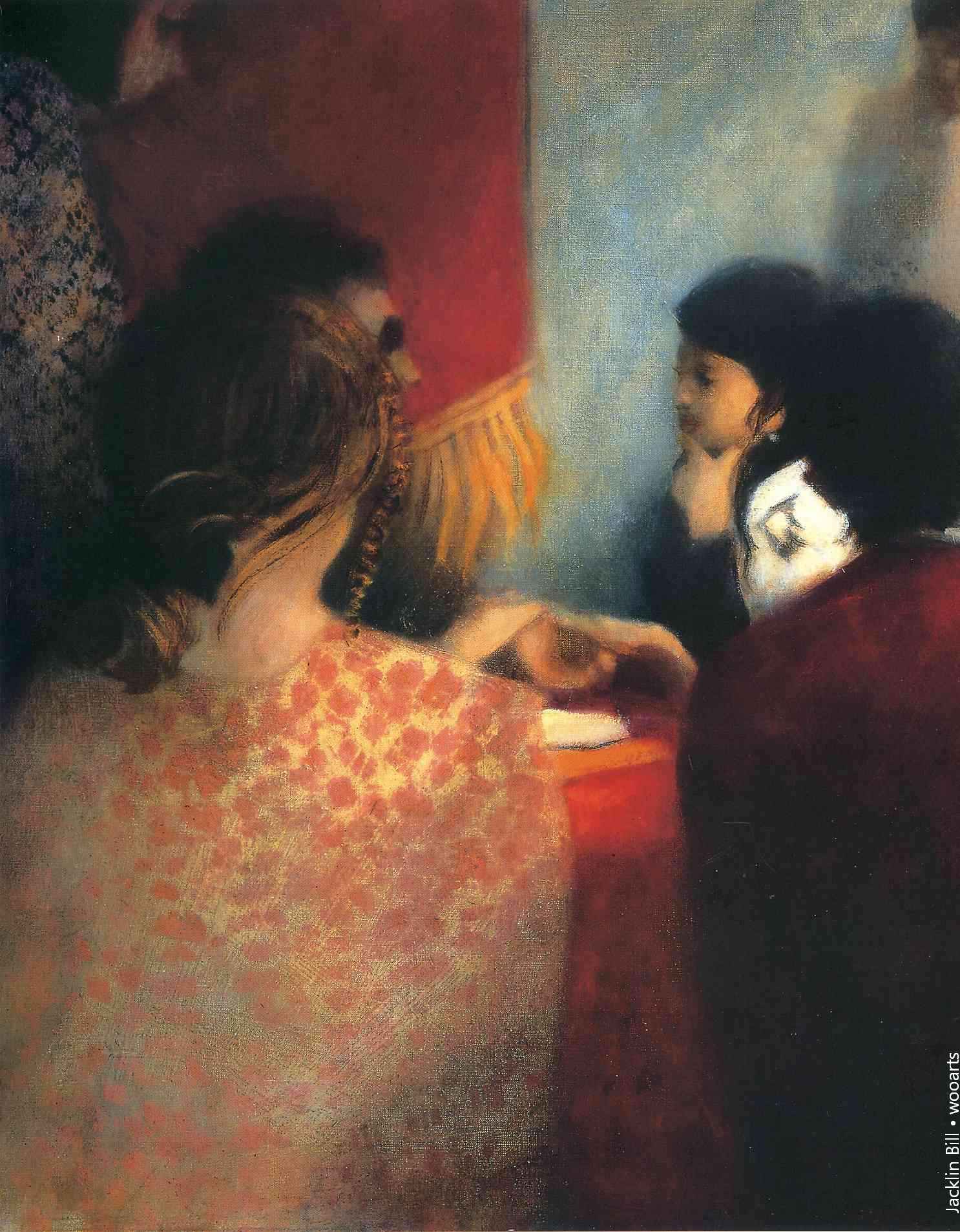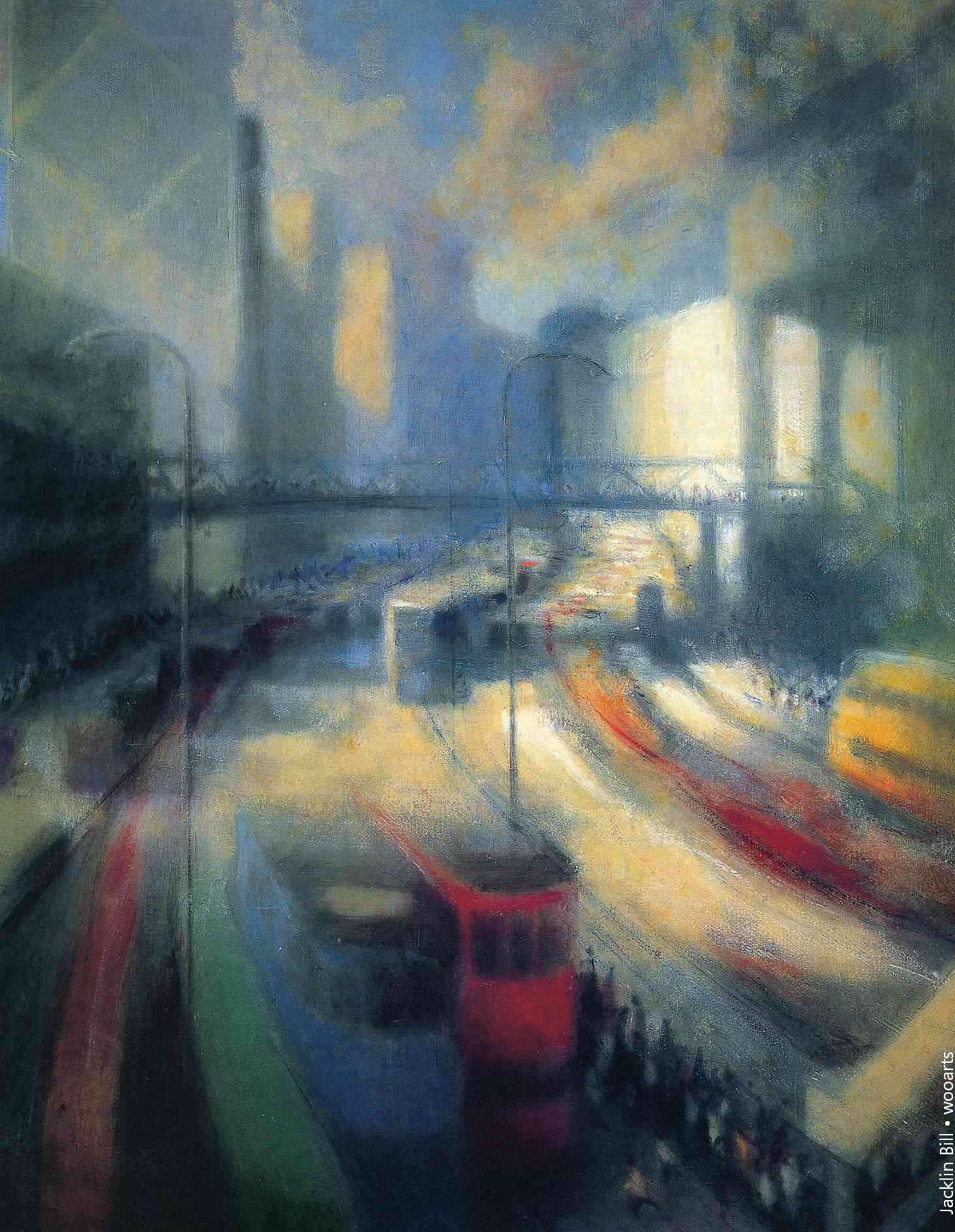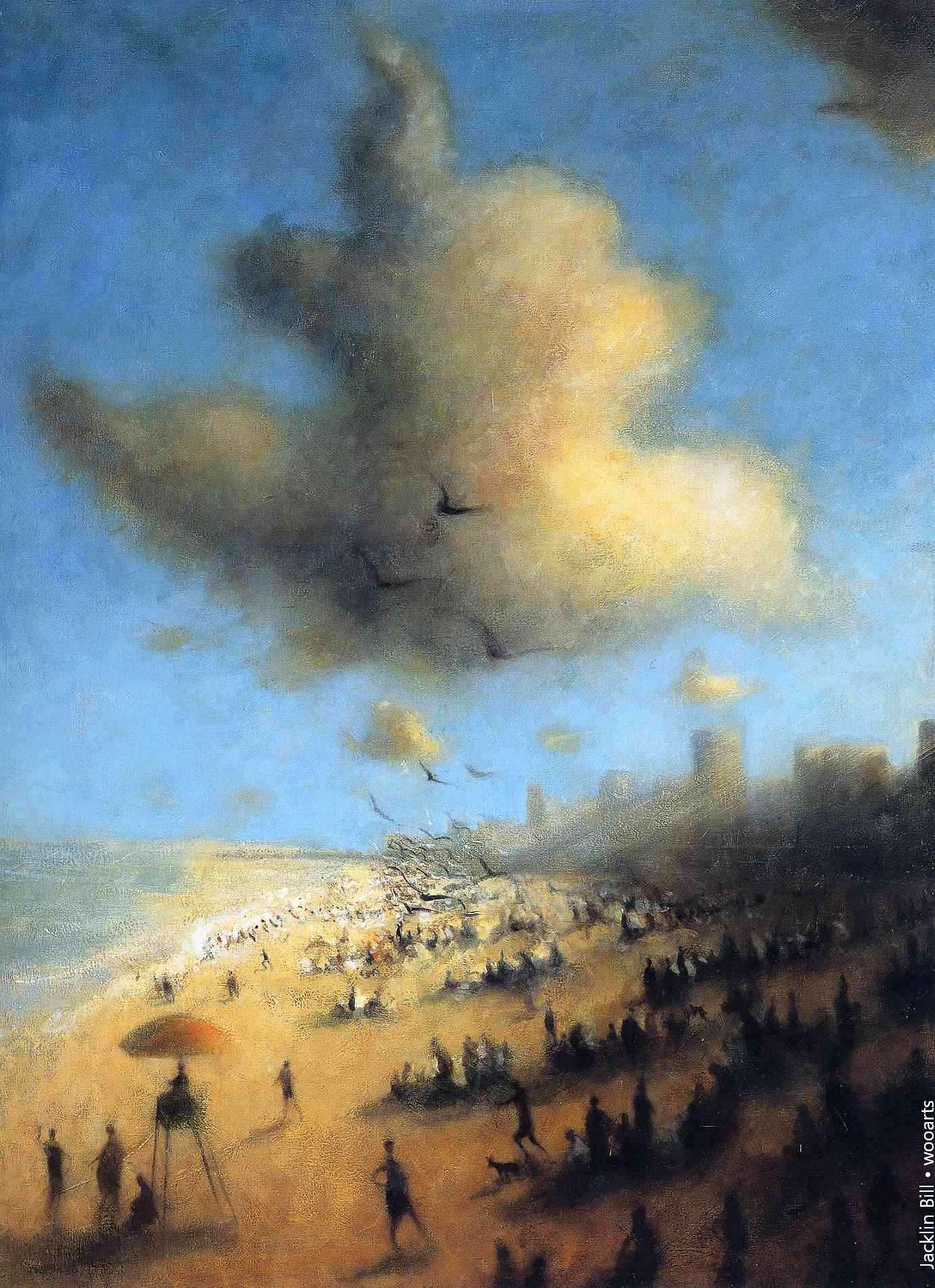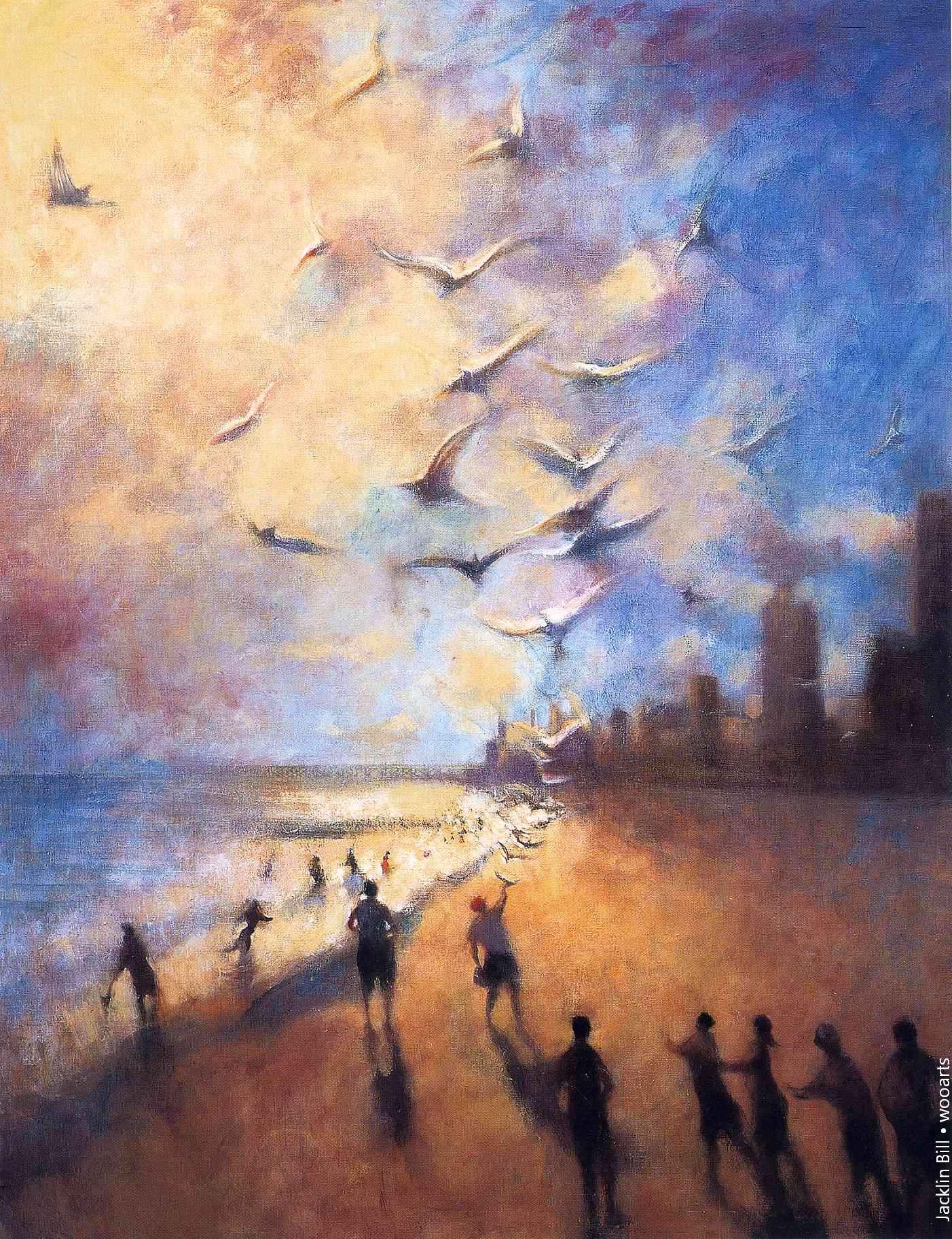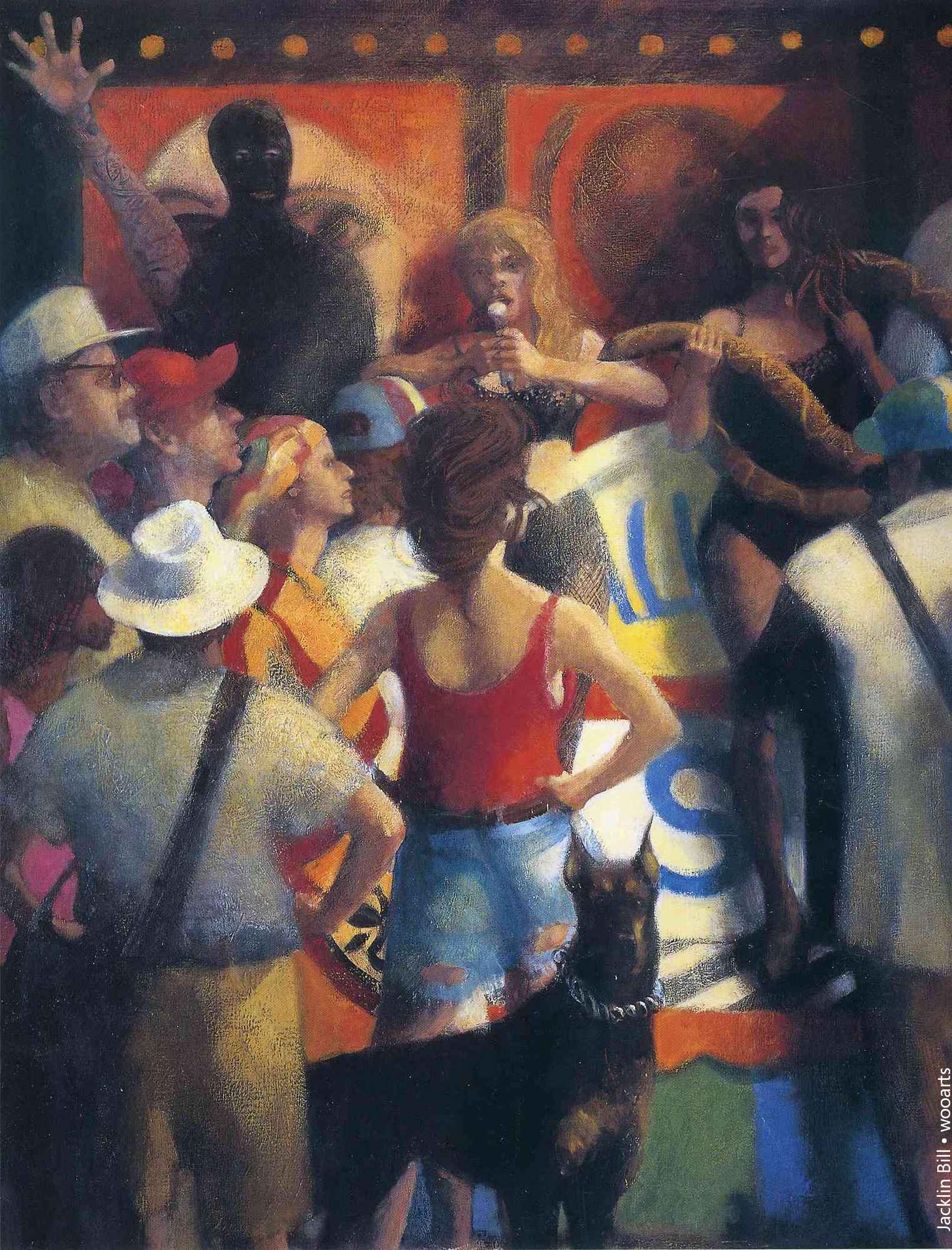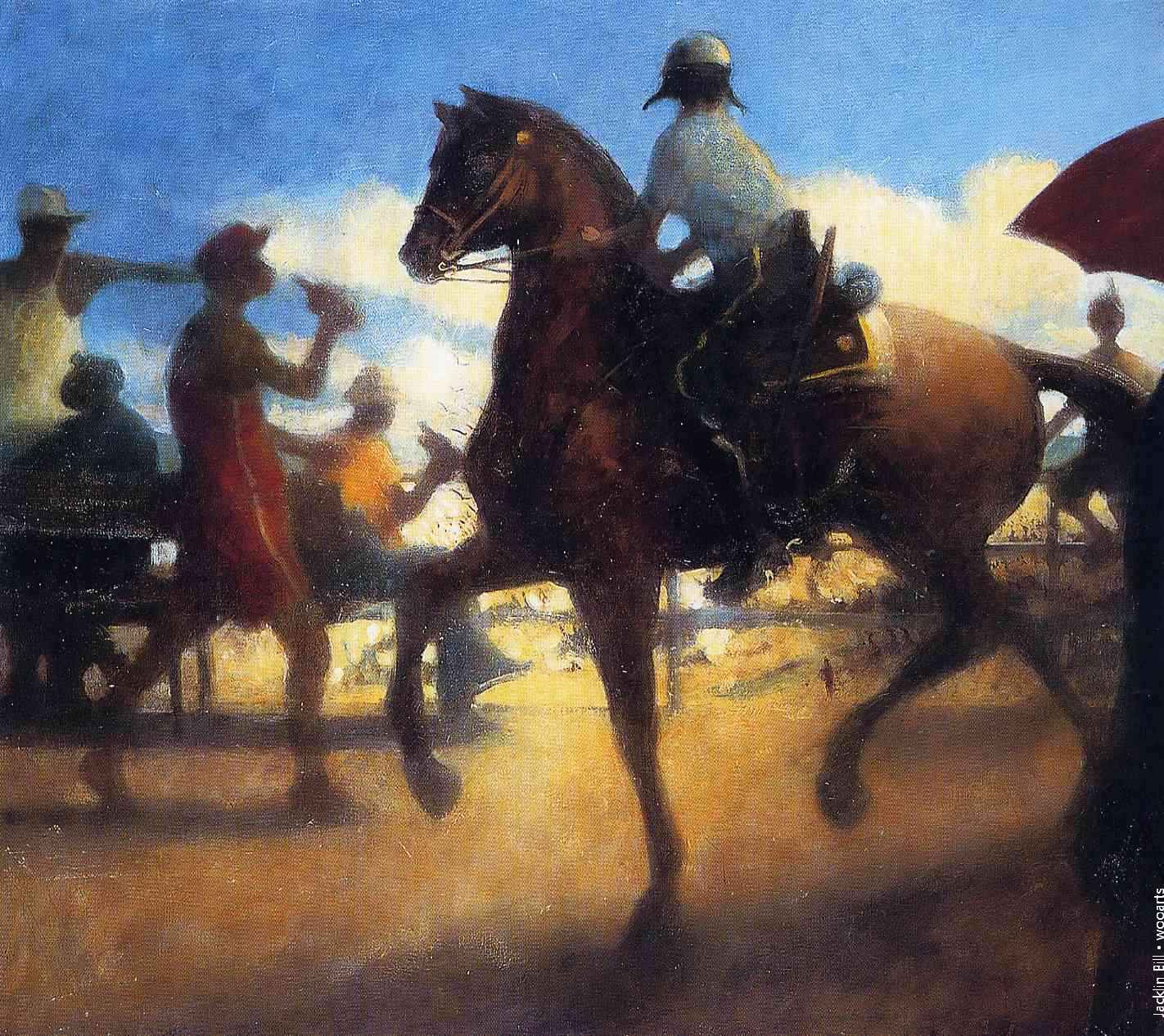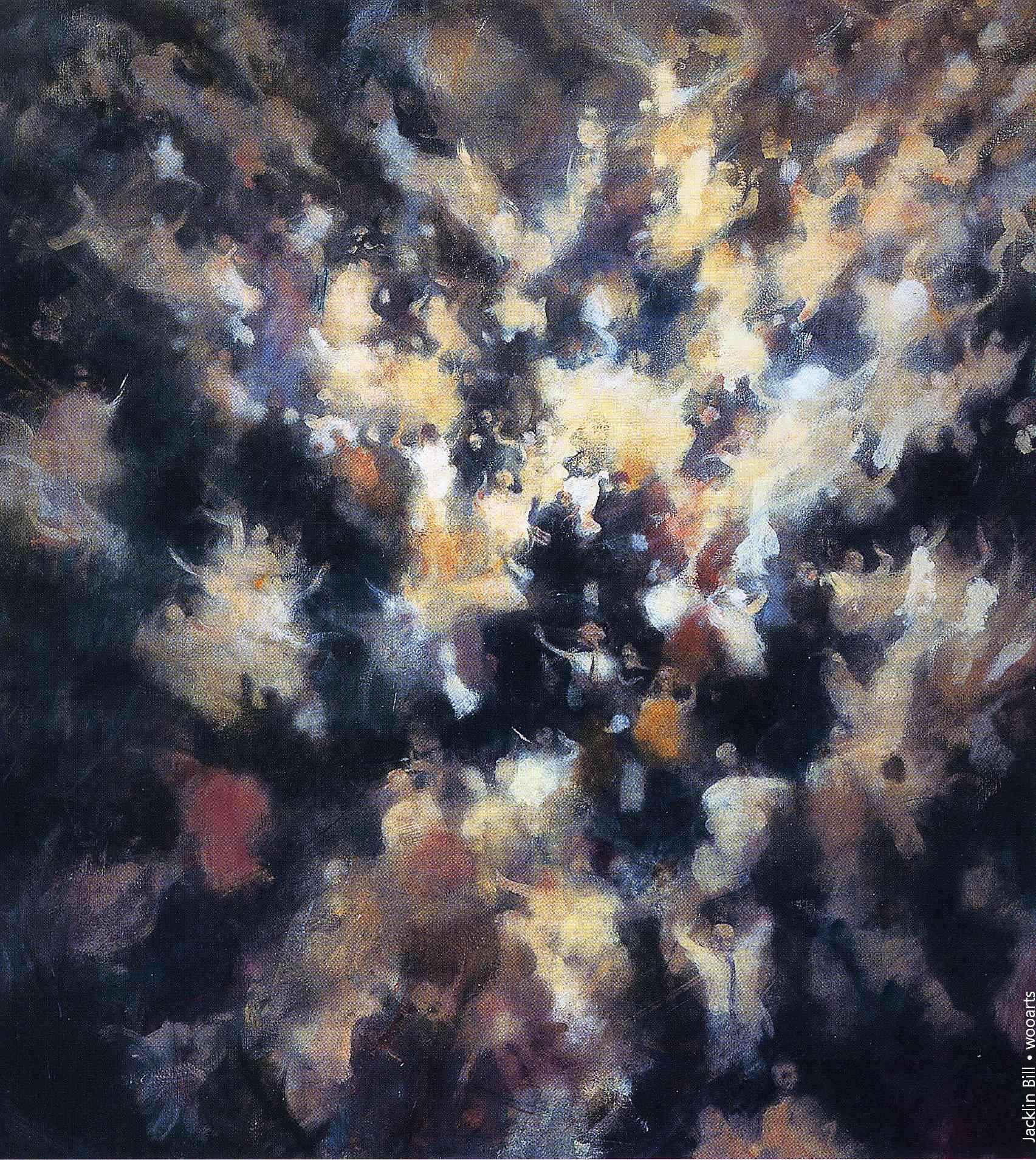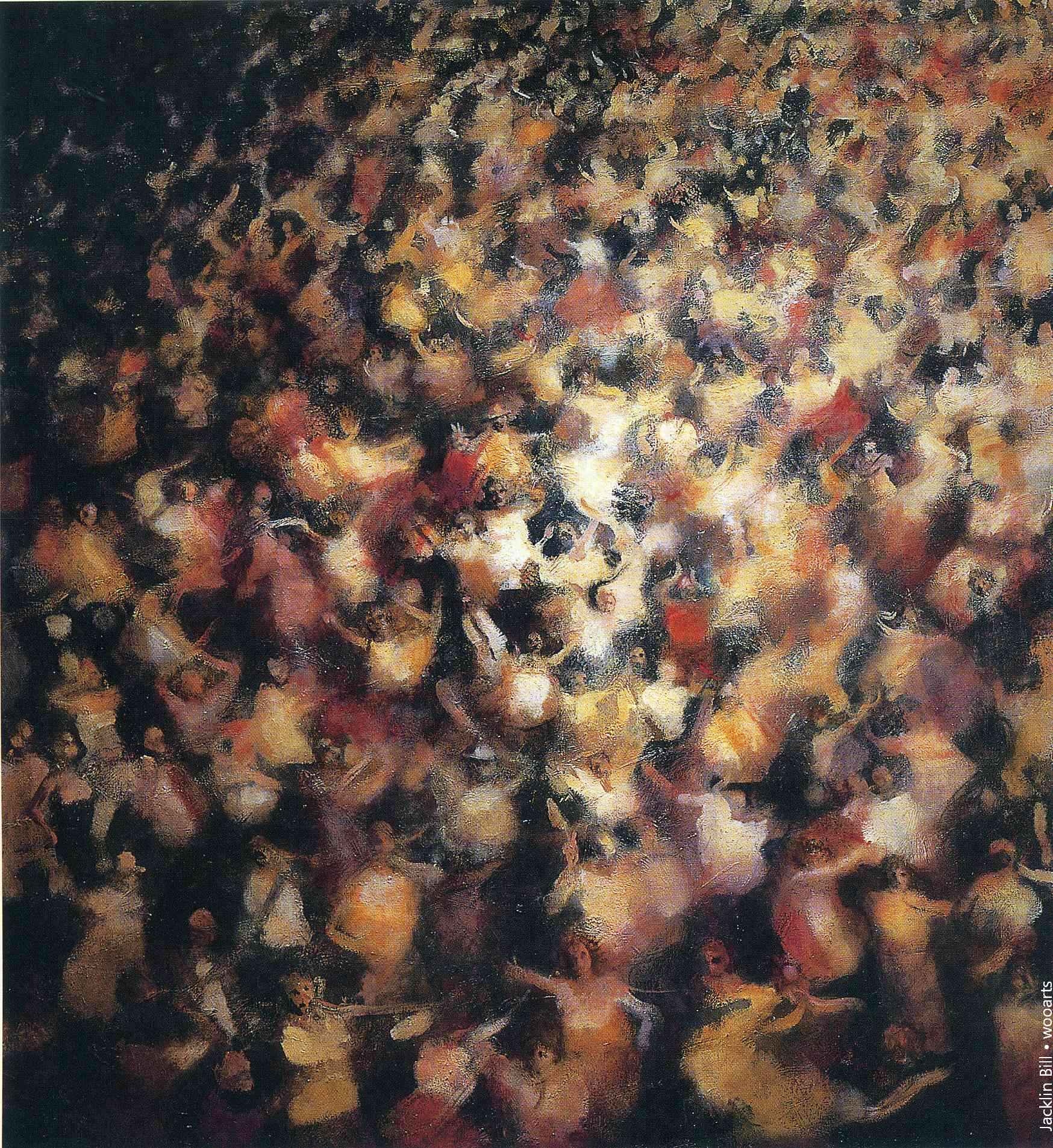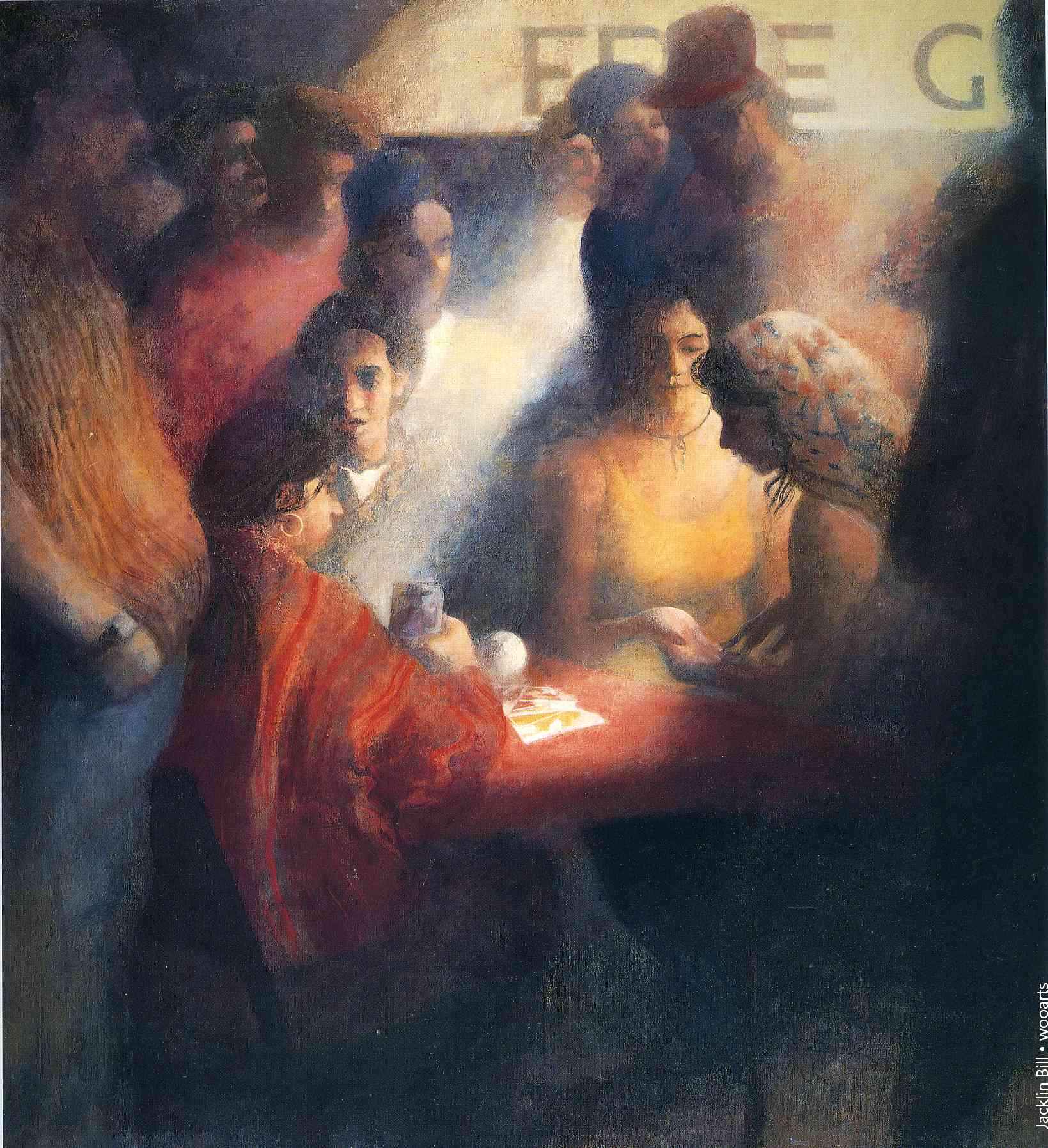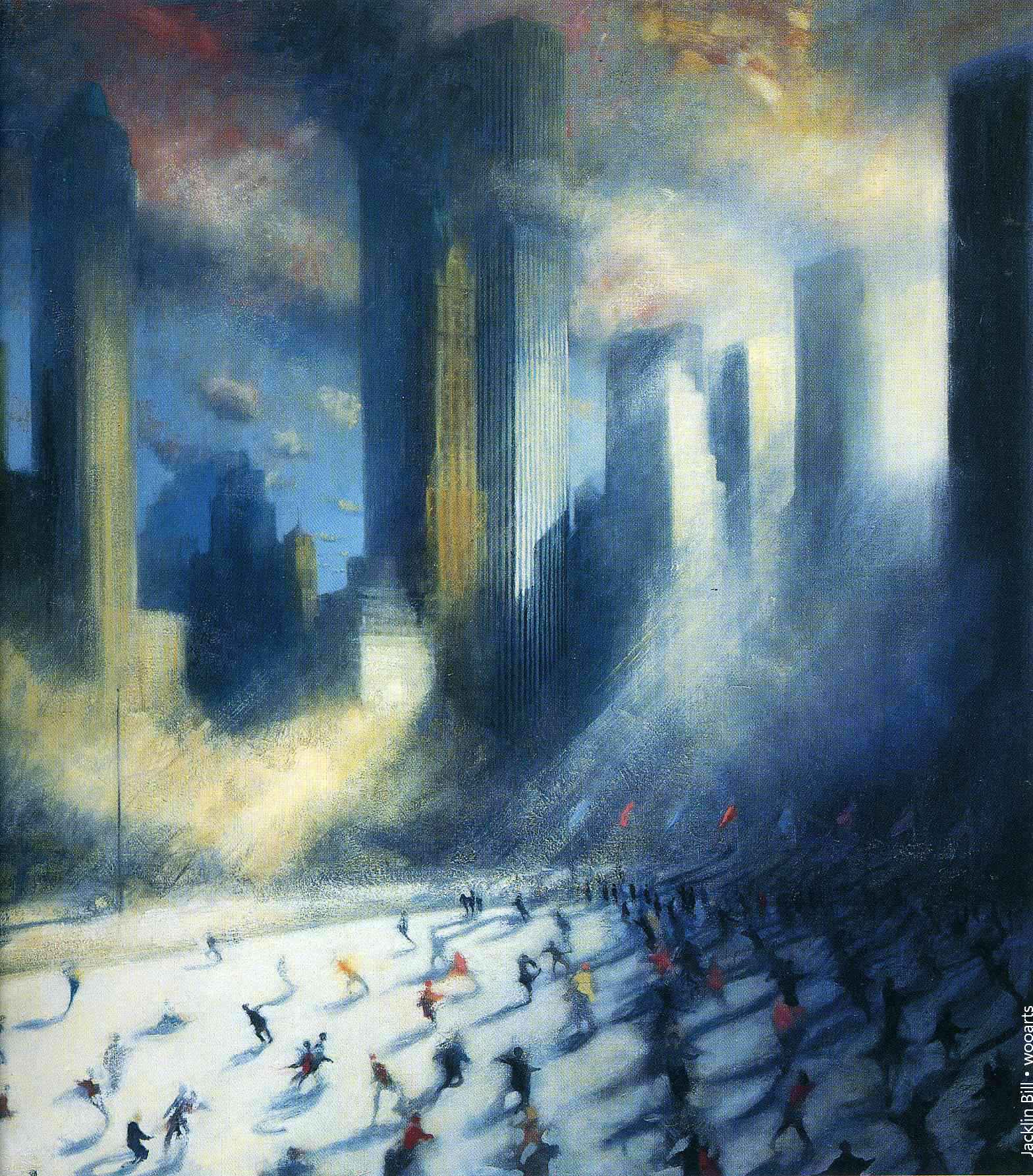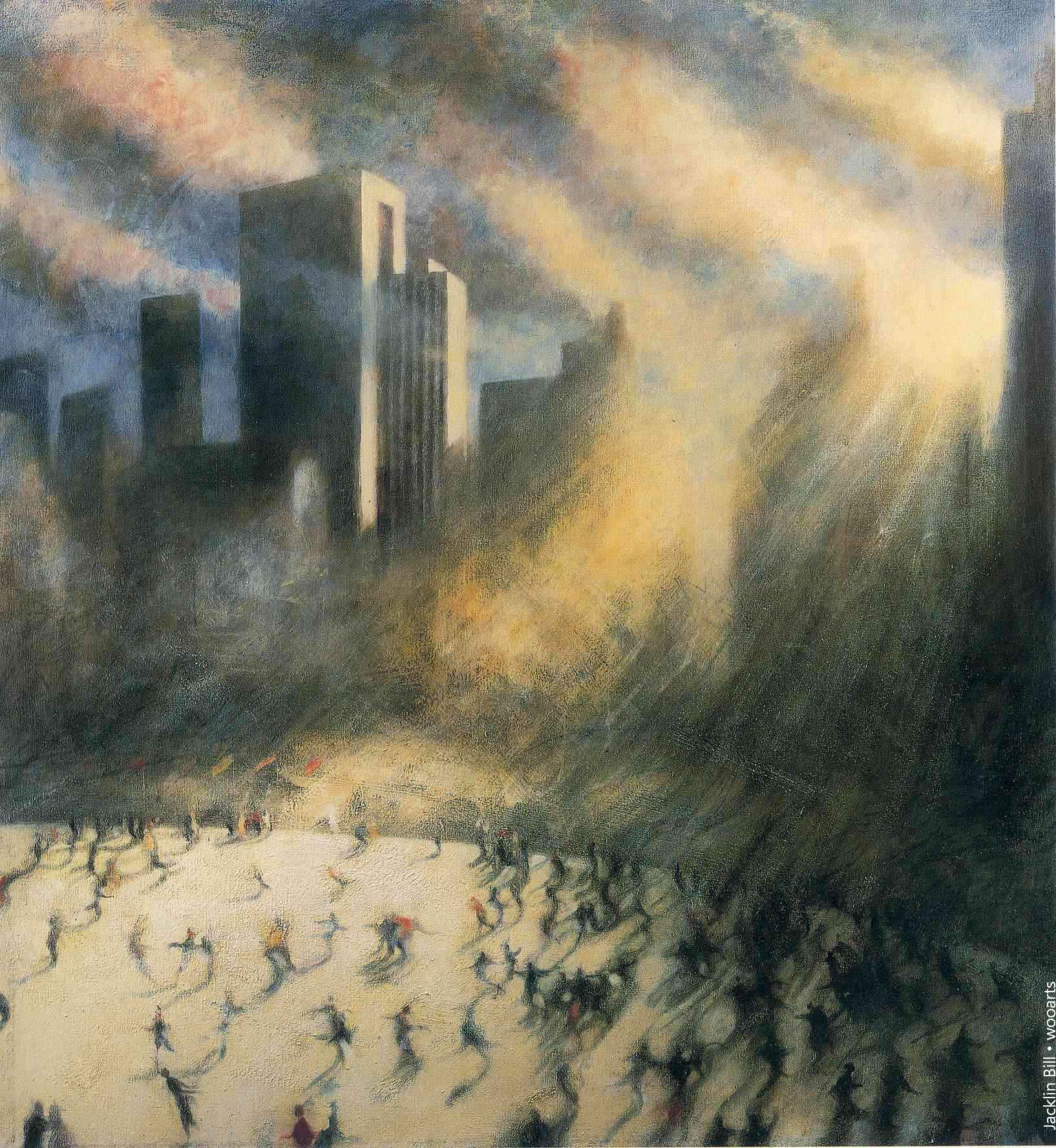(English, b.1943)
Soon after, he enrolled in the Royal College of Art in London from 1964 to 1967. Jacklin’s early career was marked by his Abstract style. However, by the mid-1970s, his work moved toward Figuration.
In particular, his pieces examined light and movement. In 1975, Jacklin held his first two solo exhibitions. One took place at Upper Gallery, and the other was held at Nigel Greenwood Inc., both of which are in London.
That same year, Jacklin was awarded an Arts Council Bursary. He held many solo exhibitions at Marlborough Fine Art, London, and at Marlborough Gallery, New York, throughout the 1970s and 1980s, and he also took part in many group exhibitions during this time period.
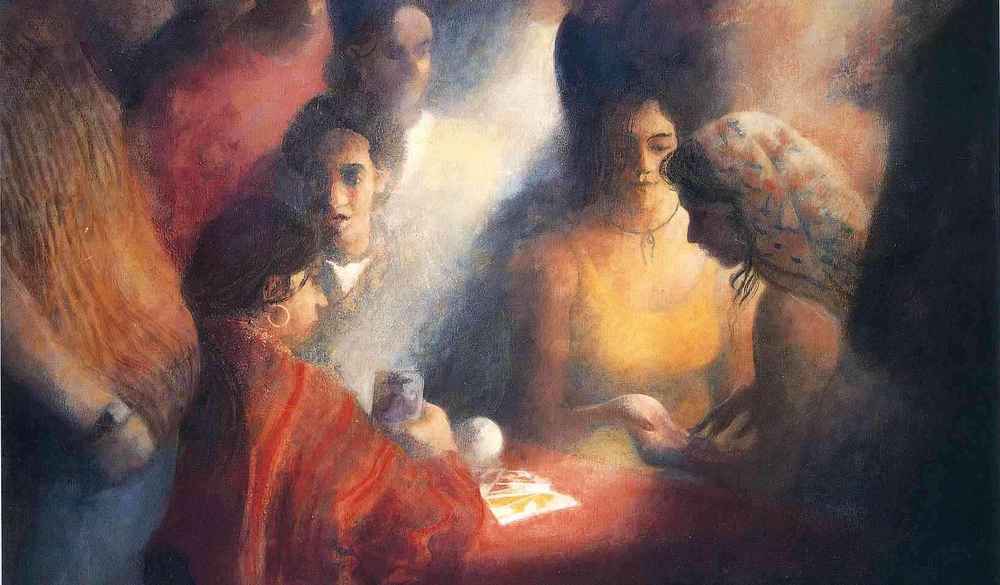
Over the course of those ten years, the artist also received many commission jobs from the Bank of England, De Beers, and the Washington National Airport, among others. In 1985, Jacklin moved to New York.
Since that time, the city has been his primary subject. His work in New York explores many different aspects of the city; his paintings often focus on the city’s famous landmarks. However, many of his paintings involve large crowds that are constantly in flux or in smaller, more intimate moments.
In 1991, Jacklin was elected a Royal Academician. Two years later, he became the Official Artist-in-Residence for the British Council in Hong Kong. Jacklin’s work can be found in many museums and galleries around the world, including the Arts Council of Britain, the Metropolitan Museum in New York, and the Tate gallery in London, which is home to such works as Northern Light and Catena. Today, Jacklin continues to live and paint in New York.
Timeline
1943
Born January in Hampstead, London
1960
Studies graphics at Walthamstow School of Art, London (through 1961)
1961
Works as a graphic designer at Studio Seven, Holborn, London (through 1962)
1964
Royal College of Art, Painting School, London (through 1967)
1975
Awarded Arts Council Bursary, Great Britain. Devotes himself full-time to painting.
1985
Relocates to New York
1989
Elected Associate Member of the Royal Academy, London
1991
Elected Royal Academician
1993
Official Artist-in-Residence for the British Council, Hong Kong (through 1994)
1997
Monograph published by Phaidon Press entitled Bill Jacklin by John Russell Taylor
2000
Makes Millenium Print for the Print Club of New York
2004
Elected a Fellow of the Royal Society of Painters & Printmakers
The artist lives and works in New York City and Newport, Rhode Island.
Exhibitions
2018
Bill Jacklin Selected Exhibitions in 2018:
Bill Jacklin: Monotypes, Marlborough Gallery, New York, NY (solo exhibition)
2017
Bill Jacklin Selected Exhibitions in 2017:
Bill Jacklin: Paintings from 1986 to 2016, Marlborough Gallery, New York, New York, United States (solo exhibition)
2016
Bill Jacklin Selected Exhibitions in 2016:
Bill Jacklin: Paintings and Monotypes, Marlborough Fine Art, London, United Kingdom (solo exhibition)
A Survey of Graphic Work from the Sixties to the Present, The Royal Academy of Art, London, United Kingdom (solo exhibition)
2014
Bill Jacklin Selected Exhibitions in 2014:
Bill Jacklin: New York Paintings, Marlborough Gallery , New York , New York , United States (solo exhibition)
2013
Bill Jacklin Selected Exhibitions in 2013:
Bill Jacklin: Paintings, Pastels & Prints, Marlborough Fine Art, London, United Kingdom (solo exhibition)
2012
Bill Jacklin Selected Exhibitions in 2012:
Bill Jacklin: Recent Work, New York, Marlborough Gallery, New York, New York, United States (solo exhibition)
Bill Jacklin: New Monotypes, Bohun Gallery, Henley on Thames, United Kingdom (solo exhibition)
2011
Bill Jacklin Selected Exhibitions in 2011:
Bill Jacklin, RA: The Lightness of Being, Brook Gallery, Devon, United Kingdom (solo exhibition)
Summer Group Exhibition, Marlborough Gallery, New York, New York, United States
2009
Bill Jacklin Selected Exhibitions in 2009:
Summer Exhibition, Marlborough Gallery, New York, New York, United States
Works on Paper, Marlborough Gallery, New York , New York, United States
2008–2009
Bill Jacklin Selected Exhibitions in 2008-2009:
Bill Jacklin: People and Places II, Marlborough Monaco, Monte Carlo, Monaco (solo exhibition)
2008
Bill Jacklin Selected Exhibitions in 2008:
Bill Jacklin: Paintings and Prints, University Gallery and Baring Wing, Northumbria University, Newcastle Upon Tyne, United Kingdom (solo exhibition)
Bill Jacklin: People & Places II – Paintings and Monotypes, Marlborough Fine Art, London, England (solo exhibition)
Summer Exhibition, Marlborough Fine Art, London, England
Group Exhibition, Marlborough Monaco, Monte Carlo, Monaco
2007
Bill Jacklin: People and Places: New Monotypes, Marlborough Fine Art, London, England (solo)
2007
Bill Jacklin: People & Places, Marlborough Gallery, New York (solo)
2007
Summer Exhibition, Royal Academy, London
2007
Sobre el Humor, Galería Marlborough, Madrid, Spain
2007
A Summer Exhibition, Marlborough Fine Art, London
2006
A Summer Exhibition, Marlborough Fine Art, London
2005
Landscape, Cityscape, Marlborough Gallery, New York
2005
Bill Jacklin: New York Skaters: Paintings and Monotypes, Marlborough Fine Art, London (solo)
2004
Bill Jacklin: Recent Monotypes, Galeria Marlborough, Madrid, Spain (solo)
2004
New York, New York, Galeria Marlborough, Madrid, Spain, September-October; Fundacion Caja Granada, Centro Cultural Caja de Granada, Puerta Real, Spain, November-December
2004
Bill Jacklin: A Venetian Affair: Paintings and Monotypes, Marlborough Fine Art, London, England (solo)
2003
La Fête, Le Bellevue, Biarritz, France; traveled to Museo Valenciano de la Ilustración y la Modernidad, Valencia, Spain
2003
Bill Jacklin: Recent Monotypes, Marlborough Gallery, New York (solo)
2002
Bill Jacklin: Central Park, New York City: Recent Paintings and Monoprints, Marlborough Gallery, New York (solo)
2002
From Little Acorns, Royal Academy of Art, Friend’s Room, London
2001
Summer Exhibition, Royal Academy, London
2000
Bill Jacklin. Silhouettes and Shadows: New York City, Marlborough Fine Art, London (solo)
2000
Elogio de lo Visible, 27 artistas en torno a la figuración, Galeria Marlborough, Madrid; traveled to Centro Cultural “Las Claras,” Murcia, Spain; Centro Cultural
1999
Summer Exhibition, Royal Academy, London
1998
Bachelier Cardonsky Gallery 10th Anniversary, Kent, Connecticut
1998
New York City: The Connected Image 1997-99, Marlborough Gallery, New York (solo)
1997
New Monotypes and Etchings, Skovridder Gallery, Oslo, Norway (solo)
1997
Bill Jacklin: New York City: The Collective Image 1996-1997, Marlborough Gallery, New York, New York; traveled to Marlborough Fine Art, London, England (solo)
1997
CityScapes: A Survey of Urban Landscape, Marlborough Gallery, New York
1996
20th Century British Art Fair, Royal College of Art, Coram Gallery, London
1995
Marlborough Graphics, London
1995
Bill Jacklin, Urban Portraits: Hong Kong 1993-1995, Hong Kong Arts Centre, Hong Kong, China (solo)
1995
Bill Jacklin: New Monotypes and Etchings, Marlborough Fine Art, London, England (solo)
1994
Bill Jacklin, University of Northumbria at Newcastle, Newcastle upon Tyne, England (solo)
1994
Art London ’94, Islington, London
1993
Summer Exhibition, Royal Academy, London
1992–1993
Bill Jacklin: Urban Portraits, New York 1986-1992, Museum of Modern Art, Oxford, England; traveled to Museo do Pobo Galego, Santiago de Compostela, Spain (solo)
1992
Urban Realities: Contemporary Portraits of New York, Walsh Gallery, Regina A.
1992
Bill Jacklin: Urban Portraits, Coney Island Series, 1992, Marlborough Fine Art, London, England (solo)
1991
New Acquisitions: British Drawings, The Metropolitan Museum of Art, New York
1990
Bill Jacklin: Urban Portraits, New York, 1990, Marlborough Gallery, New York, New York (solo)
1988
Bill Jacklin: Urban Portraits, Marlborough Fine Art, London, England (solo)
1987
Bill Jacklin, Recent Work: New York Paintings, Pastels and Drawings, Marlborough Gallery, New York, New York (solo)
1985
Bill Jacklin: Works on Paper, Marlborough Gallery, New York, New York (solo)
1983
Bill Jacklin: Recent Paintings, Marlborough Fine Art, London, England (solo)
1980
Bill Jacklin: Paintings and Watercolours, Marlborough Fine Art, London, England (solo)
1977
Hester van Royen Gallery, London (solo)
1975
Nigel Greenwood, London (solo)
1970
Bill Jacklin, Royal College of Art, Upper Gallery, London, England (solo)
Public Collections
Arkansas Arts Center, Little Rock, Arkansas
Art Collection, University of Alberta, Edmonton, Canada
Art Gallery of New South Wales, Sydney, Australia
Arts Council United Kingdom, London, England
Bayly Art Museum, University of Virginia, Charlottesville, Virginia
British Council, London, England
British Museum, London, England
Brooklyn Museum, Brooklyn, New York
City Art Gallery, Bradford, England
Contemporary Art Society, London, England
Fondation Veranneman, Kruishoutem, Belgium
Government Art Collection, London, England
Kemper Museum of Contemporary Art, Kansas City, Missouri
Library of Congress, Washington, D.C
Museum Boijmans Van Beuningen, Rotterdam, the Netherlands
National Portrait Gallery, Smithsonian Institution, Washington, D.C
Neuberger Museum of Art, Purchase, New York
Northumbria University, Newcastle upon Tyne, England
Portland Museum of Art, Portland, Oregon
Royal Academy of Arts, London, England
Tampa Museum of Art, Tampa, Florida
Tate, London, United Kingdom
The Arts Council, Dublin, Ireland
The Ashmolean Museum of Art and Archaeology, University of Oxford, Oxford, England
The Billy Rose Theatre Collection, The New York Public Library, New York, New York
The Brian Montgomery Collection, Museum of Fine Arts, Budapest, Hungary
The Fitzwilliam Museum, University of Cambridge, Cambridge, England
The Hunterian, University of Glasgow, Glasgow, England
The Isle of Man Arts Council, Isle of Man, England
The Jane Voorhees Zimmerli Art Museum, Rutgers University, New Brunswick, New Jersey
The Metropolitan Museum of Art, New York
The Morgan Library and Museum, New York, New York
The Museum of Modern Art, New York, New York
Thyssen-Bornemisza Foundation, Villa Favorita, Castagnola, Switzerland
University of Guelph, Ontario, Canada
University of Leicester, Leicester, England
Victoria and Albert Museum, London, England
Yale Center for British Art, Yale University, New Haven, Connecticut
via: artnet.com
Bill Jacklin RA on New York, his home for two decades
Published 24 May 2016
No one captures New York quite like Bill Jacklin RA, who moved to the Big Apple in the 1980s and never looked back. Nancy Campbell caught up with him ahead of his show of prints and drawings at the RA.
From the Summer 2016 issue of RA Magazine, issued quarterly to Friends of the RA.
The paintings and prints of Bill Jacklin RA celebrate places, but he does not see himself as a topographical artist. “I use location as an emotive vehicle to describe my feelings and my relationship to the world,” he explains from his Connecticut home.
The London-born artist is best known for his dramatic depictions of New York, where he lived for two decades. He records “people involved in their passions” – on parade, at the beach, in the park. These scenes are revisited and renewed in many moods and media; the swirling skaters on the ice rink in Central Park, for example, feature in a number of works, from his first hand- coloured carborundum prints (Rink I and Rink II, both 1995; pictured) to a vast mural at Washington National Airport (The Rink, 1996). The figure skater tracing elegant arcs on the ice could be a metaphor for the artist himself, his lightness of touch matched with formidable skill.
Jacklin came to prominence in the 1960s as a ‘Systems artist’, composing complex works of grids and dots. But he realised that “the avant-garde was too rigid”, and he embraced instead a free style of figuration, examining “the flow of forms and the play of light”. Commissions from the Bank of England and the London restaurant the Ivy followed, and he became a Royal Academician in 1991.
Jacklin has never lost his early enthusiasm for printmaking, as a show of his graphic art at the Royal Academy reveals this summer. After he relocated to New York in 1985, he adopted print techniques that suited his gestural approach, such as monotype, where an image is painted directly onto a plate – in Jacklin’s case, zinc plates that he inherited from the great American artist Robert Motherwell. He spritzes a mixture of turpentine and oil on the plate to create dazzling light effects.
Jacklin often works on a painting and a print simultaneously in his own studio, “moving between canvas and press, adjusting both compositions.” But he also enjoys the discipline of working separately in the studio of a master printer. Recently Jacklin produced 20 monotypes during one intense week at the Center for Contemporary Printmaking in Norwalk, Connecticut, some of which will be on show at the RA this summer. “They set up a system and I came in and hit off against it. How much can the system tolerate with me battering it?” He laughs. “Everyone was exhausted by the end of the week, myself included.” The new monotypes are impressive in scale; the most ambitious is a tribute to the Manhattan skyline. “I always thought of the city as an arena,” Jacklin concludes. “The light shining down is my spotlight, in which I can create my own drama.”
via: royalacademy.org.uk
Bill Jacklin and I have talked so often over the past thirty years, usually during long congenial evenings in London or New York, that we were both convinced we had already done an interview together. When we realized that we’d never recorded any of our conversations, we decided to try to get something on tape. In the end we snatched a moment to meet for drinks while I was in New York in November 2011. The interview could not have got off to a worse start. It was raining hard and I arrived late, having lost my briefcase and having retraced my sodden steps in a vain effort to recover it.
Jacklin listened to my tale of woe with polite equanimity, then told me of the number of wallets, credit cards and mobile phones he had managed to lose at critical moments in recent months. He had treated his last mobile phone with infinite care, he added, checking for it at night on his bedside table – only to wake up to find he had carefully settled it into a glass of water. Jacklin’s stories, like his paintings, teeter regularly on the edge of chaos when they don’t actually plunge headlong into it. Suddenly, in this vista of accidents waiting to happen, the briefcase incident receded. I began to relax and, without any plan or questions in mind, I turned the voice recorder on.
You told me once that there’s always an incident behind what you paint.
There’s always something that triggers a painting off, although the way I actually paint it comes afterwards. There has to be a force or something there in the beginning.
An experience of some sort.
An experience that excites me. So to go back, as I was telling you, I was sitting in a bar with a friend in 1985, about a week after I’d arrived in New York. And there was a crash and a bang and it was obvious that someone had shot somebody outside the restaurant that I was sitting in. I was sitting at the bar and a bullet came across and ricocheted and hit down at the end of the bar and there was a silence and then I heard a voice say, ‘Oh my God, he’s coming in.’ Whoever it was then hit the deck, so there was another silence and then everyone appeared to hit the deck. And what I got, as I started to hit the deck, was the impression that the wine bottles and the glasses moved this way and everything was on diagonals. So I fell to the floor from my stool at the bar. And then there was another silence, and suddenly everyone sort of collectively decided they better get the hell out of there. So everyone started running out towards the kitchens at the back. And it was mayhem in so far as there was one moment of silence and the next moment it was chaos. The result was that I don’t think the man ever did actually come in. But there was someone who was shot in the eye and he was taken to hospital and the police came and we were all kind of huddled in the kitchen, then everyone started to leave, and being the only Englishman there, I was the only one actually saying, ‘Well, can I pay my bill?’ Then I realised that this was a different place and that the cashier was looking at me like I was just crazy and I’d just said the craziest thing. And that was my first impression of Manhattan.
And is the memory of the various things that have happened to you in New York still coming through in the paintings you’re doing now? Are they recollections or reflections of events?
Well, yes, I think everything is a reflection of itself. I think it’s all about how you receive things. Maybe we want to recapture the dramas that we’ve had. You know, I was thinking as I was walking over to talk to you this evening that I was born in 1943 when the Doodlebugs were dropping on London, and I was trying to work out what it is that gives you the sense of actually being alive, and I think certainly in those early years I had a heightened sense of being alive through those bombs, that were like an external force. I think you’re a product of your time, and I was a war baby. As a result, certainly in artistic terms, I was brought up with a whole kind of existential group of people that had a particular attitude to how they perceived the world. And I guess I became part of that. But I was sufficiently younger not to be philosophically in tune with a pessimistic way of viewing the world. I basically viewed the world as post-war, and I’m still caught up by the idea of drama and the drama of life.
That we can be extinguished from one second to another?
Well, the idea that you go very quickly from a structure to a sort of chaotic situation. My early artistic career had a kind of parallel of non-figurative equivalence, of drawing structural things that were systematic and held in abeyance what I perceived to be chaos, a chaotic situation. I thought that if you put together all these ramifications you could hold chaos.
But are the more recent paintings about chaos, because some of them are apparently celebratory scenes, with people enjoying themselves at the beach or in restaurants?
That’s what I aspire to but there’s always a kind of dark shadow moving over and the sense of people wanting to escape. I don’t have any a priori principles or beliefs. I don’t have a position. I have a kind of anxiety, if you like. But I have an aspiration beyond that anxiety.
Which is what?
Well, it comes from being a post-war baby. I mean, like I was part of that Sixties moment in the way you rejected a certain position about how everything was dire, everything was black and the black cloud hovered over everybody and every day you could wake up and have…
So are you saying your paintings are either about a fragile stability, a fragile order, or about chaos to a large extent? Is it order on the edge of chaos, or is chaos always lurking under the surface?
Well, yes, I think chaos always is lurking, I think we’re all aware of that. And we’re well aware of what’s going on in the world right now. I’ve always been interested in what’s going on around me and for quite a while now I’ve felt much more like a reporter of my time than someone who’s involved in artistic pursuits. I’m not part of an artistic culture. I’m way beyond that, I’m too old for it. Like at the moment I’ve been down at Zuccotti Park to paint, I go down there to paint like a reporter.
To look at the people in protest against Wall Street…
And I want to be involved in what’s going on right now. I don’t have a philosophy about it. I just have an instinctive position.
Did you know you were going to start painting those kinds of scenes, or did you just go and look and then suddenly you thought, this is something I’d like to get down on canvas?
I think it’s to affirm a sense of life. As I said, I don’t have a particular ideological position but I do believe in being at the centre of energy. I mean, my paintings are above all about energy. I’m a closet abstractionist and I’ve always been that way. I find ways of swirling things out of focus, so they become something else. Maybe in another lifetime I’d have made a movie. I don’t have an adherence to style. I don’t have a stylistic position within the art world because that for me is a kind of death sentence.
But you actually came out of abstraction?
I came in and out of abstraction. My early work was very much a reflection of what I was looking at. After that as I got more involved in the art world and had some degree of success, I got more involved in systems of painting which ultimately I determined were less interesting.
You mean in the 1970s, when the art world was very given to theory?
Yes, and I thought that was fine in its way but that it was better for me to kind of walk away from it.
And come back to life?
Come back to waking up every morning and having a sense of energy, a kind of “How do I see the world?” I think in the end every artist is based on that very simple principle. You wake up in the morning and you say, how do I see the world, how do I feel, and what do I want to say? And even if it’s in a contradiction of what you did yesterday, there’s a life to it. And that seems to me to be the most wonderful thing to be able to do.
But this isn’t a political consciousness, is it?
It’s a consciousness of what you see around you, what strikes you and what you want to try and record. It’s an affirmation of life. You know, for quite a few years I taught. Most artists didn’t have any money in those days and they taught in order to kind of sustain what they did, and you saw young students going into the library to try and find a language that would allow them to feel that they were on the road to being an artist. And they were often starting with manifestation. They weren’t starting with impressions.
By manifestation you mean?
What to do about it, what to paint. And in my view it always was, I always felt, what am I receiving as an artist? What food am I getting, what am I getting from this street light that I’m looking at, what am I getting from the people I’m talking to? Impressions that you can say something about. You start from stage one, you don’t start from stage two. You never say, “How am I talking?” You say, “And what am I talking about…?”
The subject.
The subject, and that seems to be even more important now because as the art world becomes more and more about money and it becomes stultified and becomes all about business, the real question is how do you cut through that and say: “What am I looking at, how am I receiving this?” And that’s not just artistic, that’s life.
From these impressions that you receive, whether it’s the incident in the bar, where a bullet comes whistling through, or a feast that you’ve seen and appreciated in a restaurant in Little Italy – do you think very closely how am I going to relay this on the canvas? Do you start doing drawings or compositions? Do you say, oh I should get that fat waiter in or the dog snapping around at the end of the table? Or do you just go in and reinvent as you go along?
Well, I think it’s about a sense of place. I think a lot of artists, a lot of painters, speak about space and the relationship that you have with it. And I think a lot of the best work is all about that relationship. It’s not about the image. The image is important, but it’s the relationship you have with something, it’s the relationship you have with anybody, at any moment. Like when I’m speaking to you: I have a sense of being with you and there is that moment of space between us. If you look at a wonderful Rembrandt self-portrait, what you’re actually aware of is the space between you and him. That’s what the emotional content of your relationship is and that is the relationship, not just the image. So in anything, if I’m really serious, I’m aware of being in a place at a certain time and it becomes a memory for me ultimately, that has a resonance for me. And it’s real. It wasn’t concocted. And if it was concocted and if I’m critical enough, then I’ll say, “That wasn’t so good, it was a concoction.” But if it was real, I know it.
Do you have a very clear idea about what you want to paint, or at least an overall impression, before you start a canvas? Or is it very spontaneous?
Usually in terms of the process of how I work, because of the life in the particular areas I’m working in, I have a kind of figurative base. I know for example that if I’m working on a group of people in Times Square everything will move and change, often quite dramatically. So much of my work is about movement, you know, that I don’t hold to a rigid structure at all.
But does this come from a drawing to begin with or do you go straight into the canvas?
I use whatever I can. I’ll work from drawings, and I’ll work from a sense of being in a place. For me it’s very important that I was there.
But not from photos?
Well, I’ll take whatever I can. But there was an intense period when I went scouting around on different locations in the city like 42nd Street, which was a lot rougher then, and Sheep Meadow, that amazing green arena in Central Park. A lot of the time I went round with Abe Frajndlich, a photographer friend of mine. I drew, he took photos, and I think we were both influenced by the way the other made images of the exact same thing we were both looking at.
Sure. But you might have taken the photos yourself ?
I might have, or I might not. If I fail in the image that I make it’s because I didn’t make it my own. And that’s all.
And do you know when you’ve made it your own?
I serve myself into it, so that it’s coloured by my feelings because it’s a subjective process that we’re involved in here. I don’t pretend to think it goes beyond that.
Do you judge one of your paintings according to how successful you were in imparting your own feelings to it?
I’m always totally in conflict about that. I’m confident enough to know that I’m engaged in the dialogue. I’m not confident enough to believe that what I saw was real and every day I wake up and feel that there is another opportunity to see the world. At the end of the day, Michael, I just want to say that as I get older I’m hitting a certain point. I want to be able to say to myself that I kind of saw something and I had the presence of mind to record it in a way that has a resonance. So when I paint, if I’m talking in formal terms, I’ve always said to myself, well the painting is a residue of what happened. I don’t just put it down, because it seems to me everything is always shifting and changing and moving, and if I try consciously to find a way for painting something, it won’t work. I don’t know in advance how a picture is going to come out. That’s why I still believe in painting. I still believe it has a relevance because the very simple old-fashioned process of hand to canvas allows an immediacy, you know, it’s not technically rigid.
It’s straight down the nerve ends.
There is still a kind of touch, a feel, by which I can say something. I think the less interesting work for me is where someone’s identity is attached totally to their stylistic content.
Yes, because it becomes empty.
I think the most interesting artists are the people who have a handwriting and their stylistic content maybe can shift and change accordingly. Once it goes into that place, and every artist knows that, where you try to hold on to something that’s already been done or seen in some way, it always has its downside. You have to cut through that. So it’s not easy.
So how would you describe your average day in the studio?
You know, Michael, I basically spend my time sitting alone in a room, viewing the world through the reflections on a doorknob – or on water or whatever – reflections of something I’ve seen or experienced, but at one remove.
You want the distance or a different angle on a moment that you’ve lived through?
I think of the artist as a voyeur, the person who’s watching. There’s the observer and the observed, right? You’re watching the world go by, and you’re watching your own life go by. Time is ticking.
So you’re snatching a moment?
You’re waking up to the moment. Because I think a lot of the time you go through your life when you’re not aware of the moment. You’re caught up in things and not very aware. Then this very particular moment comes along, and a very particular feeling – of being removed. Some people might call it loneliness.
Is that what Joyce called an epiphany – an unusual awareness of existence? And is that when you think you’ve got a picture, an image, when you have this moment of heightened reality?
The image is another stage. What you do about it is another whole issue. You might or might not make something of that feeling. You know, in New York, you‘re always out on location, the whole city is a location. I paint about an energy mass, it gets figurized in various ways, if you like, but it’s actually about a flowing, pulsating energy. That’s what Manhattan is – it shifts and changes, people love it or hate it, but it’s always pulsating.
This is what attracted you to New York in the first place, isn’t it?
Yes, I found my subject. It was a conduit for me to experience all those things that excite me. When I first arrived, every street corner I went round I found something. New York, for want of a better word, is my muse. Suddenly all these images were given to me that I could transform. And what really transfoms them for me – I should have mentioned it earlier – is light. Light, or the absence of it, holds everything together. I look at certain scenes, certain situations, and I see either light or darkness and that to a large extent decides how I paint. Light is spirituality and emotion. Light for me is everything.
Yes, that comes across very strongly in your pictures. And it’s often as though one doesn’t know how long the light will last before darkness descends… To change focus for a moment, who are the artists you look at with most pleasure? I believe Seurat is one.
Did I tell you the story of buying a little Seurat when I was quite young? Well, I had a show in the West End and there was a gallery in Davies Street and I went in and I saw a little Seurat drawing. I didn’t know it was a Seurat drawing at the time and I didn’t have any substantial money, but I had £1200 to spend and there were certain contemporary artists that I could buy, but only a graphic. And I went into this little gallery in Davies Street run by a man called Christian Neffe, and there was an artist called Josef Herman who had bought a little Seurat drawing and I admired it. There were Bonnards there and Vuillards, and I always had an affinity to that kind of attachment to urban life they had towards the end of the last century. I’ve sometimes felt I was out of my own time in a funny kind of way. Anyway, the drawing had been bought, but about a month later Christian called me and said, that drawing of Seurat is available again if you’d like it. I said I don’t have that kind of money, I’ve only got £1200.
So what did he say?
Well, he said you can have it for £1200, so I bought it and I’ve had it ever since. It’s always been a kind of little spiritual supplement.
What’s the scene?
It’s a man sitting on a little donkey, an art school donkey. It’s not one of his big expensive charcoals; it’s just a very minimal little pencil drawing. But it was the idea that there was someone viewing urban life in another century that drew me to it.
You are an urban person, you like big cities and you like going around and watching people carry on and…
Yes, I’m basically a street kid. And I’m an observer, a voyeur, as I said. And the relationship between the observer and the observed is a very interesting one. You know, it’s always in flux. I mean why I like Manhattan is because it’s contradictory, it’s not what it seems, nothing is what it seems. You know there is always a moment where things will happen, that you’re taken unawares, you have your wallet stolen or you lose your briefcase and you’re always on one foot. What interests me is that sense of waking up in the morning and being alive and feeling that you can go out and see something and from that perspective I really am an old-fashioned artist. I have a sketchbook and I sit in a corner and I draw things and I make notations of things that I’ve seen. And they are notations and they are dots and splushes and blibs and blobs and they are actually the subjective equivalent of something seen. It’s not a record.
It’s your notes.
It’s a subjective equivalent.
But to finish, so it would be Seurat, Vuillard, Bonnard and…?
And then I wrote my thesis as a student at the Royal College of Art on Rauschenberg and Jasper Johns. So if you like you make a sandwich and you make a BLT, it’s really what you show, it’s like the top of it can be the bacon or the lettuce or whatever, and although a lot of people will only see what’s on top, the sandwich is compressed of…
Different layers?
That’s right. You could say Seurat was a very important influence on my life but so was Rauschenberg and so was Jasper Johns. When I was student I did a philosophy class at the Royal College and Iris Murdoch was my tutor for three years. So I had all that English sandwich compressed into me as well.
I hadn’t thought of you as a sandwich before, but I’ll look anew to see what level I’m at.
I think we’re all a bit of a sandwich really.
In one of the interviews I did with a painter friend called Miguel Condé, I tried to pin him down about something and, you know, he clearly wasn’t going to be pinned down and he wriggled out by saying: ‘I’m just a salad of comings and goings.’
There you are. I think we all are.
